Oct 20, 2025
Top 39 AI Recruiting Startups Transforming Hiring in 2025
From sourcing to screening, AI recruiting startups are modernizing recruitment with faster, fairer, and more accurate hiring solutions.
Every hiring manager knows the grind: sifting through hundreds of resumes, juggling sourcing channels, and watching the hiring pipeline slow down while good candidates slip away. AI Recruiting Startups are changing recruitment automation by combining resume parsing, candidate matching, automated screening, interview scheduling, and predictive analytics to speed sourcing, lift candidate experience, and boost hiring efficiency. If you want powerful, affordable AI recruiting tools that save time, attract better candidates, and help you build high-performing teams faster, this article will point to the right startups, explain ATS integration, and show how to choose recruitment software that fits your budget and goals.
Noxx's AI recruiter helps you reach those targets by automating outreach, ranking talent, and filling interview slots so your team spends less time on screening and more time on hiring decisions. It stays affordable and works with your existing ATS, so you can start improving candidate quality and time to hire quickly.
Table of Contents
What are the Key Hiring Challenges Startups Face?

Startups lose momentum when hiring misses. Data shows 23 percent of startups fail because of the wrong team, gaps in skills, founder disagreements, or poor hiring choices.
That statistic translates into real costs:
Slowed product development
Missed market windows
The founder was sucked into firefights instead of strategy
Ask yourself: Can you afford a hire that drags the company backward? This framing makes hiring a strategic decision, not an administrative chore.
Money Matters: Limited Budgets and Cost Pressure
Most startups cannot match the salary and benefits packages of established firms. Recruiters, job boards, and executive searches add fixed costs that strain the runway.
When funds are tight, hiring becomes a series of trade-offs between:
Speed
Quality
Cash preservation
To reduce cost per hire without sacrificing candidate quality, affordable recruiting solutions for startups use:
Low-cost sourcing
Pay-per-hire plans
Subscription hiring software
That financial pressure forces founders to prioritize hires with a clear impact on product and revenue.
Battling Bigger Brands: Competing for Top Talent
Large companies win candidates with predictable career paths, perks, and an employer brand.
Startups must sell opportunity:
Equity upside
Rapid ownership
Learning at scale
That pitch works for some candidates but not all. Recruiting automation, employer branding tools, and targeted sourcing help startups highlight mission, remote work options, and rapid career trajectories to the talent pool that prefers risk and growth. Can your story sway candidates who value autonomy over stability?
Speed Versus Quality: Time Constraints and Founder Bandwidth
Founders wear many hats. Hiring often competes with:
Product
Sales
Fundraising
Slow screening and chaotic interview loops extend time to fill and increase bad hires. Without a dedicated HR team, processes break down:
Inconsistent interview feedback
Rework job descriptions
Unclear scorecards
Recruitment automation, applicant tracking systems, and interview scheduling software remove manual steps, preserve founder time, and standardize evaluation so you hire faster with fewer mistakes.
Culture Fit When Every Hire Changes the Team
In small teams, each person influences culture and output directly. Technical competence alone does not:
Predict collaboration
Resilience
Alignment with mission
Startups need a structured cultural assessment:
Clear values
Behavioral interview guides
Work sample tests
This reflects day one responsibilities. Tools that capture candidate responses, score against your values, and feed into a talent pipeline make it easier to see how a hire will integrate with existing teammates.
How Recruitment Software Lets Startups Scale Smarter
To reduce manual work, recruiting platforms combine:
Applicant tracking
Candidate sourcing
Hiring automation
These systems use machine learning for:
Resume parsing and candidate matching
Chatbot assistants for screening
Automated interview scheduling
Teams can focus on high-impact decisions. AI recruiting startups deliver predictive:
Hiring signals
Recruitment analytics
Automated outreach
These improve the quality of hire and reduce time to hire while controlling cost.
Reach and Diversity: Widening Talent Pools with AI
Online hiring platforms expand your candidate pool beyond local markets. Remote hiring, international sourcing, and diversity-focused pipelines bring broader skills and perspectives. AI can surface overlooked candidates through skills matching and resume parsing, improving diversity and reducing bias when configured correctly. Candidate sourcing tools and talent rediscovery features also tap passive candidates who are not actively applying.
Pay Less, Hire Better: Cost-Effective Models and ATS
Modern hiring platforms offer tiered pricing, pay per hire, and usage-based credit systems that align with a startup budget. Applicant tracking systems replace legacy hiring agencies for much of the workflow:
Posting to multiple boards
Parsing resumes
Centralizing feedback
Tracking recruitment metrics like:
Cost per hire
Time to fill
Combine cloud-based ATS with inexpensive assessment tools, and you get enterprise-level capability without enterprise cost.
Speed, Fairness, and Experience: Candidate Journey with Automation
Candidates form opinions quickly. These factors damage the employer brand:
Slow replies
Clumsy applications
Unstructured interviews
These factors improve candidate experience:
Automated status updates
Simple one-page applications
Mobile-friendly screening
At the same time, structured assessments, scorecards, and interview rubrics supported by recruiting software reduce subjective bias and make hiring decisions more consistent.
What To Look For: Must-Have Features in Affordable Recruiting Solutions
Applicant tracking system with:
Easy job posting
Resume parsing
Candidate pipelines
AI-driven candidate matching and resume screening to quickly surface the best fits.
Interview scheduling automation and calendar integrations to cut back and forth.
Automated outreach and chatbots for initial screening and candidate engagement.
Work sample testing and coding assessments that reflect real tasks.
Recruitment analytics and dashboards for:
Time to fill
Cost per hire
Source effectiveness
Candidate relationship management to nurture passive talent.
Integrations with HRIS, payroll, and video interview tools to close the loop.
Security, compliance, and data privacy are integrated into the hiring process across regions.
Flexible pricing:
Pay per seat
Per posting
Consumption-based tiers
How To Start: Practical Steps for Lean Teams
Define the most critical hire for the next six months and build a simple scorecard that links skills to measurable outcomes. Run a short trial of an ATS and one AI recruiting startup tool to compare candidate match quality. Automate scheduling and screening first to free up the founder's time. To increase reach at a low cost, use:
Referrals
Targeted job postings
Remote hiring
Track basic metrics weekly so you can iterate on sourcing channels and interview structure without guessing.
Related Reading
What Features To Look For In Recruitment Software?

Wide Professional Network That Expands Your Talent Pool And Creative Thinking
A platform must plug you into many professionals across:
Roles
Industries
Experience levels
Startups do not have time to wait for one channel to work. Access to a broad talent pool increases the chance of finding specialized skills and people with startup experience. Look for systems that combine an active candidate network, integrations with recruiting CRM databases, and links to niche communities for:
Engineers
Designers
Sales pros
Operators
How will this platform surface passive candidates and people outside your usual channels
Efficient Candidate Sourcing With AI-Driven Precision
Startups move fast. AI-driven matching, semantic search, and resume parsing cut sourcing time by surfacing candidates who match:
Skills
Culture fit signals
Role requirements
Smart filters let you prioritize:
Recent experience
Remote readiness
Salary bands
It makes them focus on quality applicants. Expect tools that learn from your hiring decisions through machine learning recruitment and predictive hiring models to improve suggestions over time. What filters and scoring signals does the product use, and can you tune them for your hiring needs
Multi-Channel Compatibility So Your Job Posts Reach Active Talent
Candidates live on:
Social platforms
Job boards
Niche forums
Messaging apps
A strong platform publishes and manages postings across:
Many channels
Supports programmatic job advertising
Tracks source attribution
Integration with LinkedIn, GitHub, industry boards, and social campaigns increases reach and helps lower cost per hire.
To improve candidate experience and employer branding, also check for:
Outreach automation
Email sequencing
Branded career pages
Which channels drive your best hires, and can the software post and track performance across them
Recruitment Analytics That Turn Data Into Better Hiring Choices
You need numbers to improve speed and quality. Look for dashboards that show:
Time to hire
Cost per hire
Source of hire
Interview to offer ratios
Candidate drop-off points
Diversity metrics
Recruitment analytics should let you run A/B tests on job copy, measure sourcing ROI, and forecast hiring velocity based on the current pipeline. Use these reports to tighten your hiring funnel and to justify budget and headcount to leadership. Can you export raw pipeline data to run custom models or connect to your business intelligence tools?
Applicant Tracking And Workflow Automation That Saves Small Teams Hours
To focus on decisions, an ATS with automation for:
Interview scheduling
Offer templates
Structured scorecards
These free recruiters and founders. Resume parsing and automated stage moves reduce manual work. Integration with calendar apps and video interview tools cuts coordination friction and improves candidate response rates. Ensure the system supports role-based permissions and simple collaboration so hiring managers can leave feedback easily. How much time will these automations save your team each week?
Candidate Experience And Employer Brand Signals That Increase Responses
A poor experience kills offers. Look for software that sends timely status updates, provides mobile-friendly application flows, and supports personalized outreach using templates and sequencing. Candidate feedback forms and simple scheduling reduce no-shows and increase conversion. Employer branding features like customizable career pages and branded emails help signal professionalism even when your team is small. Which parts of the process feel polished to applicants, and which feel manual?
Screening And Assessment Tools That Raise Hiring Quality Without Slowing Speed
Automated skills tests, structured interviews, and AI-assisted screening can filter out unfit candidates while keeping high-potential people in the pipeline. Semantic search and natural language processing help find transferable skills that simple keyword matches miss. Balance automation with human checkpoints so you do not over-rely on black box models when hiring for culture fit or leadership roles. What checks does the platform offer to prevent biased outcomes in screening?
Scalability And Integrations, So The System Grows With You
Choose platforms that scale from one recruiter to a growing talent team. Open APIs, single sign-on, and integrations with HRIS and payroll systems avoid future migrations. A recruiting CRM that stores candidate histories and engagement tracks will protect recruiting knowledge as hires come and go.
Confirm the vendor supports:
Compliance
Data exports
Backup
These factors make hiring data stay accessible and auditable. Which integrations are must-haves for your stack, and which can wait
Security, Privacy, And Compliance That Protect Candidates And Your Company
Startups must handle candidate data responsibly. Verify the platform offers:
Role-based access
Encryption at rest and in transit
Support for local data rules
Look for consent management, retention policies, and audit logs so you can meet hiring compliance without heavy manual work. Can the vendor provide SOC or ISO reports and clear data processing agreements?
Choosing The Right Platform: Practical Criteria To Compare Vendors
Compare products on measurable criteria. Score them on candidate quality from their network:
AI matching accuracy
Channel reach
Analytics depth
Automation breadth
Integrations
Security
Total cost of ownership
Run a trial hiring sprint using a fundamental open role and measure:
Time to fill
Interview-to-offer ratio
Candidate satisfaction
Ask about support SLAs, onboarding services, and whether you keep access to exported data if you leave which vendor gives you the best tradeoff between:
Speed
Accuracy
Long-term data ownership
Related Reading
• Automated Candidate Screening
• AI and Recruiting
• Remote Hiring Tools
Top 39 Best AI Recruiting Startups
1. Noxx: Fast Hires, Low Risk
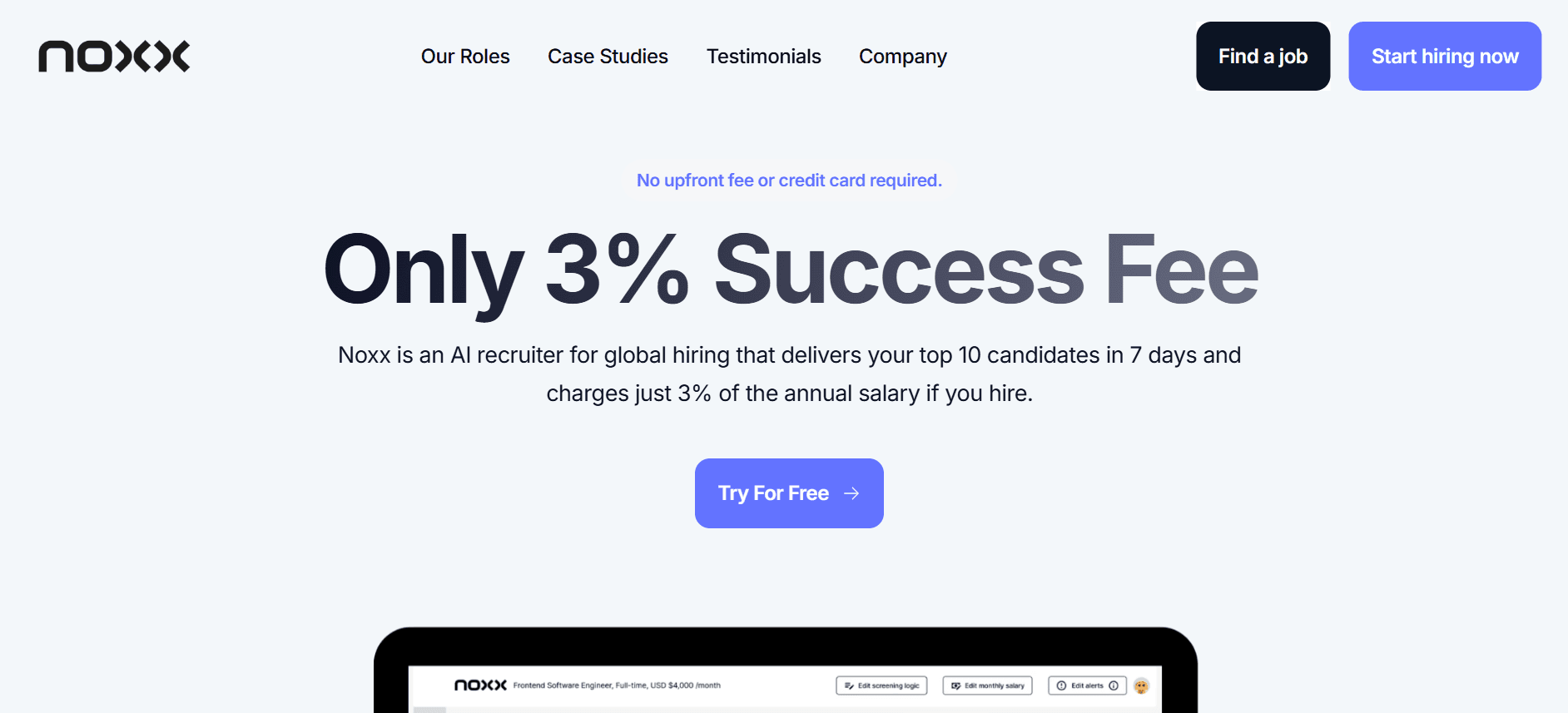
Noxx is an AI recreter built for startups that need fast, affordable hiring. The platform screens over 1,000 applicants, surfaces the top 10 candidates in seven days, and displays salary expectations up front. It automates sourcing, screening, and outreach while letting you pay $300 only if you hire, lowering cost and time to hire for engineers, marketers, and sales talent at rates up to 70 percent below US benchmarks.
Standout Features
Rapid candidate discovery: screens 1,000+ applicants and returns top 10 in seven days
Outcome-based pricing: $300 fee only when you hire, no upfront costs or recruiter commissions
Salary benchmarking surfaced during sourcing to align expectations early
Automated screening and ranking to prioritize quality fits for startups
Pros
Very low-risk, high-speed hiring that significantly reduces time and cost per hire.
Cons
Focused pricing model favors hires; less value if you need longer candidate pipelines or executive searches.
2. Tidyhire: Scale Outbound Sourcing with Automation
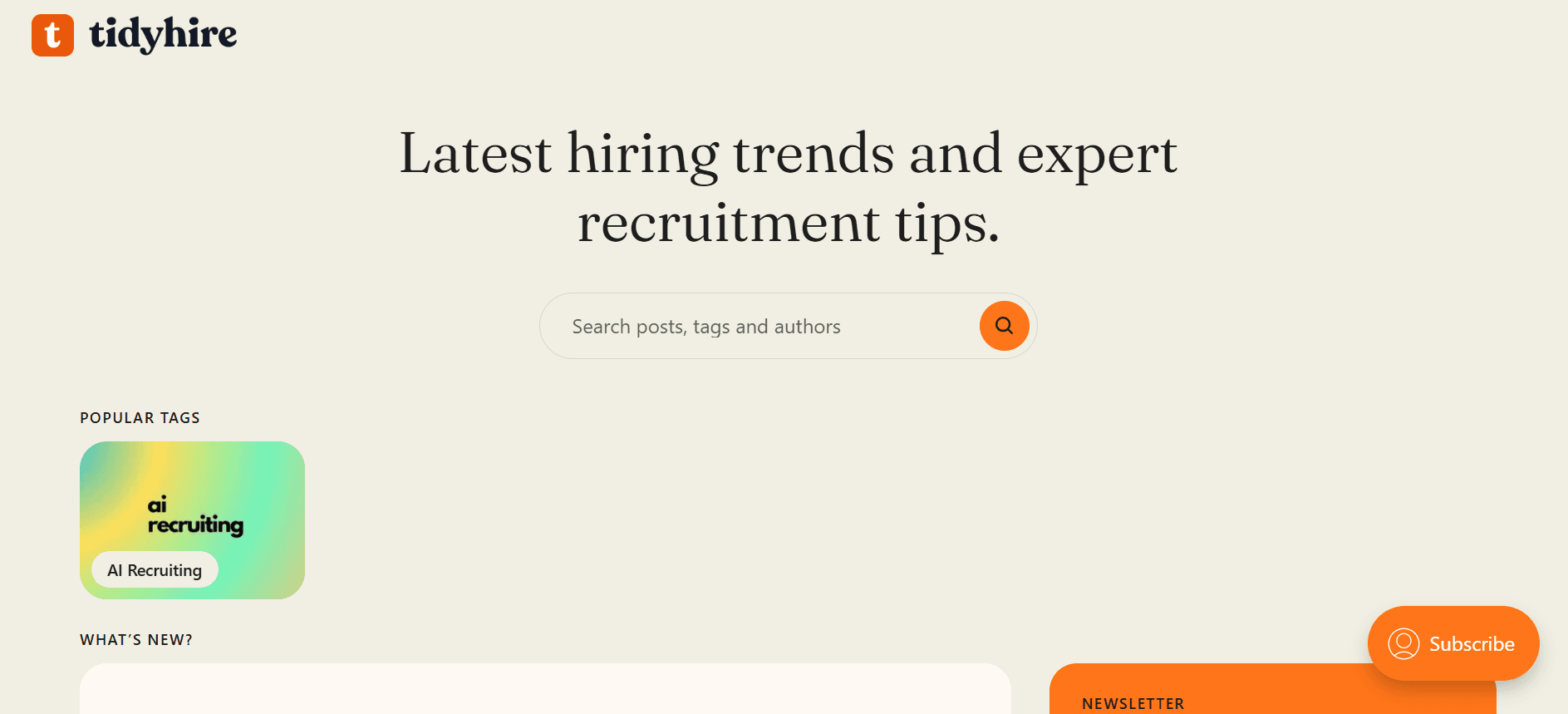
Tidyhire uses AI assistants like RIA and Charlie to automate sourcing, follow-ups, and first-round interviews so hiring teams can scale outreach without losing candidate connection. The platform emphasizes structured, bias-reducing assessments and multilingual engagement to capture global talent for startups that need repeatable recruiting automation.
Standout Features
Automates sourcing and follow-ups with AI-driven workflows for outbound hiring
Real-time candidate assessments and structured, bias-reducing interview tools
Supports 32 languages for global candidate engagement
Integrates with 300-plus tools, including Slack, Teams, ATS, and CRM platforms
Pro
This tool saves recruiters' time by:
Automating sourcing
Screening
Communication
Cons
Advanced AI features may require time and training for smaller teams.
3. Workable: Broad Reach Hiring Made Simple
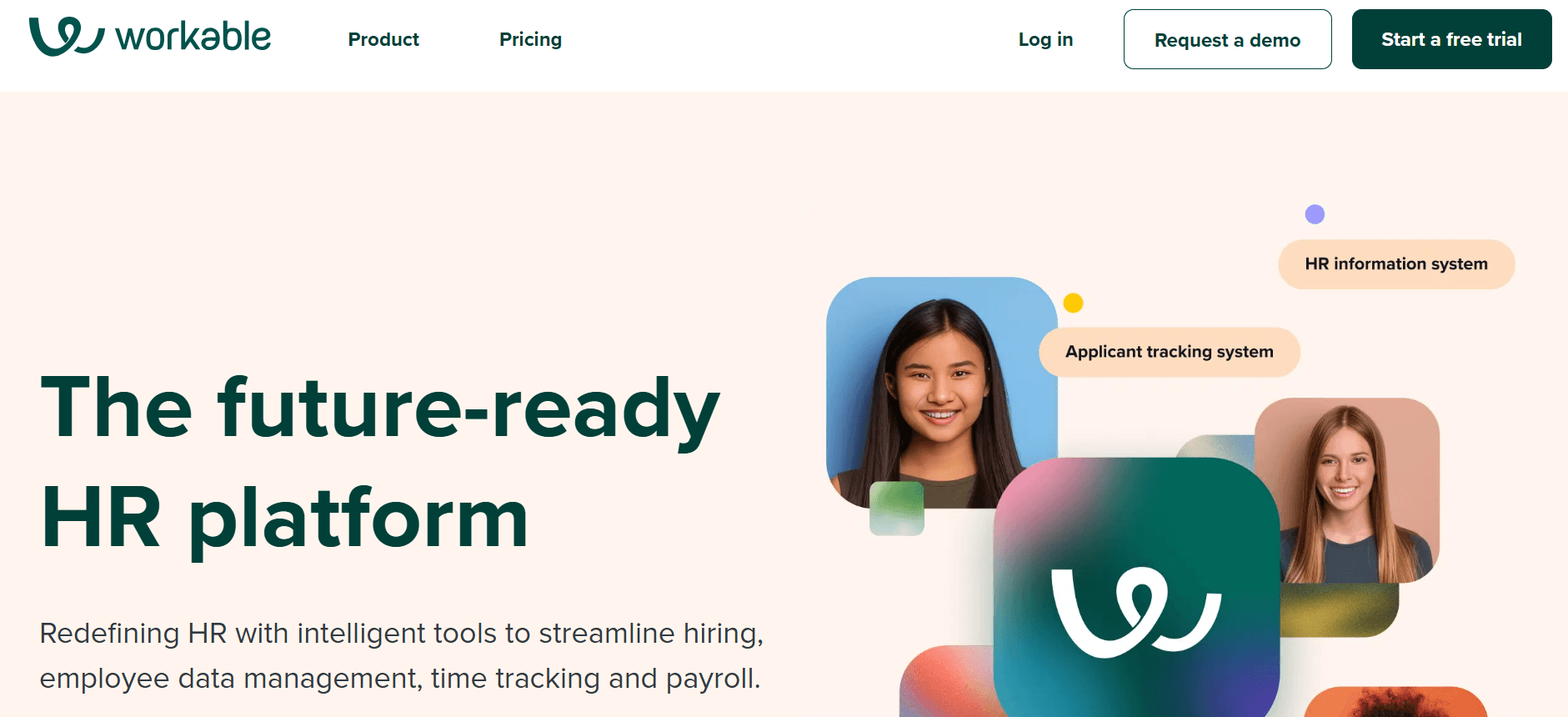
Workable is an all-in-one ATS that handles everything in one interface:
Job postings
Candidate collaboration
Reporting
It distributes roles widely, standardizes hiring workflows, and provides analytics that help teams iterate on recruiting strategy while keeping operations straightforward.
Standout Features
Distributes job postings across 200-plus job boards to boost visibility
Team collaboration tools for sharing notes and feedback instantly
Detailed reports and analytics to measure hiring efficiency
Mobile app for managing hiring on the go
Pros
Easy to use and strong on collaborative hiring workflows.
Cons
Lacks native integrations with some virtual meeting tools, requiring workarounds.
4. LinkedIn: Professional Network with Deep Talent Signals

LinkedIn doubles as a recruiting platform and professional network, giving recruiters advanced filters and direct outreach to passive and active candidates. Recruiter tools add richer profile signals and messaging templates that improve candidate engagement and sourcing precision for talent acquisition teams.
Standout Features
Advanced search filters for precise candidate targeting by skills and roles
Personalized InMail templates to scale outreach with a professional tone
Pipeline collaboration tools for team-based sourcing and shortlisting
Comprehensive profile insights for strategic candidate evaluation
Pros
Access to a massive professional database and direct outreach channels.
Cons
Subscription costs can be high compared to other recruiting tools.
5. Indeed: High-Volume Visibility and Cost Control
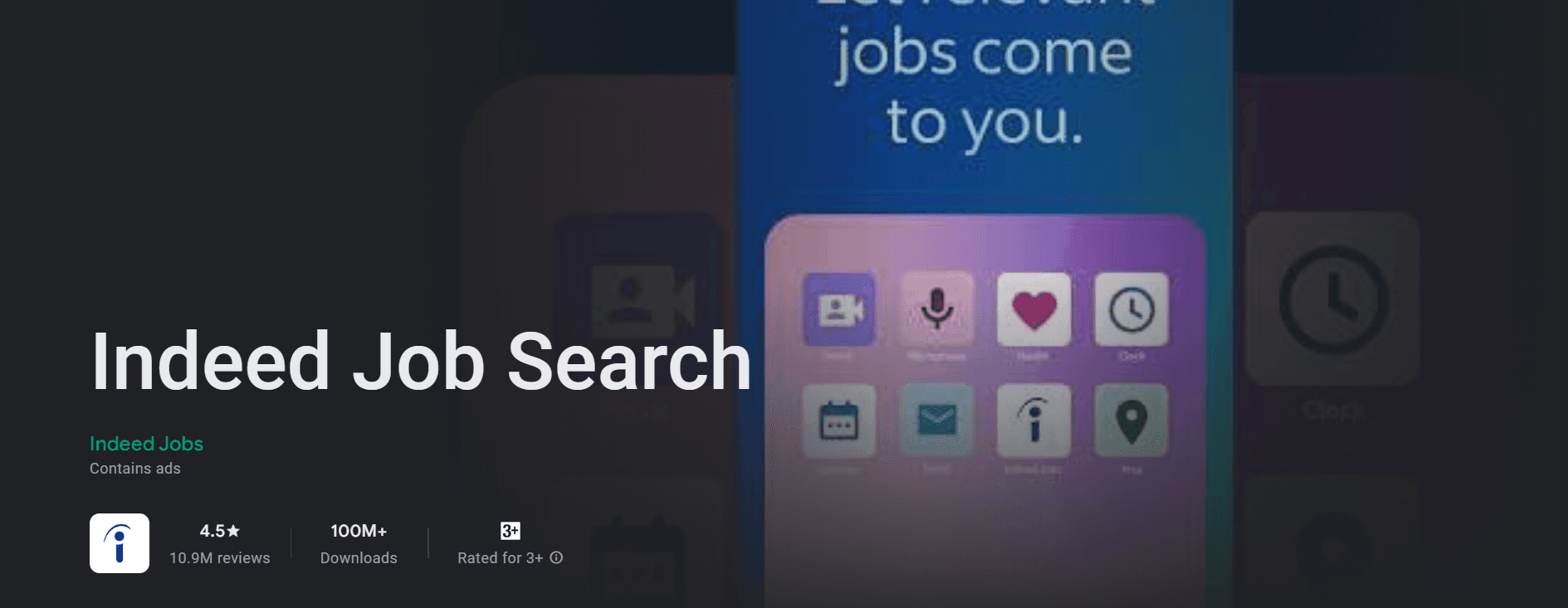
Indeed is a global job search engine that gives startups broad candidate reach and cost control via sponsored listings. Its resume search and AI pre-screening tools help filter large applicant volumes so hiring teams can focus on qualified prospects.
Standout Features
Sponsored job ads with a pay-per-click model to boost priority roles
Resume search access to millions of candidate profiles worldwide
AI-driven pre-screening questions to filter applicants early
Real-time analytics to track ad performance and ROI
Pros
Large talent pool and flexible ad spend make it cost-effective for volume hiring.
Cons
High applicant volume often requires extra screening to find qualified matches.
6. Greenhouse: Scalable Process and Deep Analytics
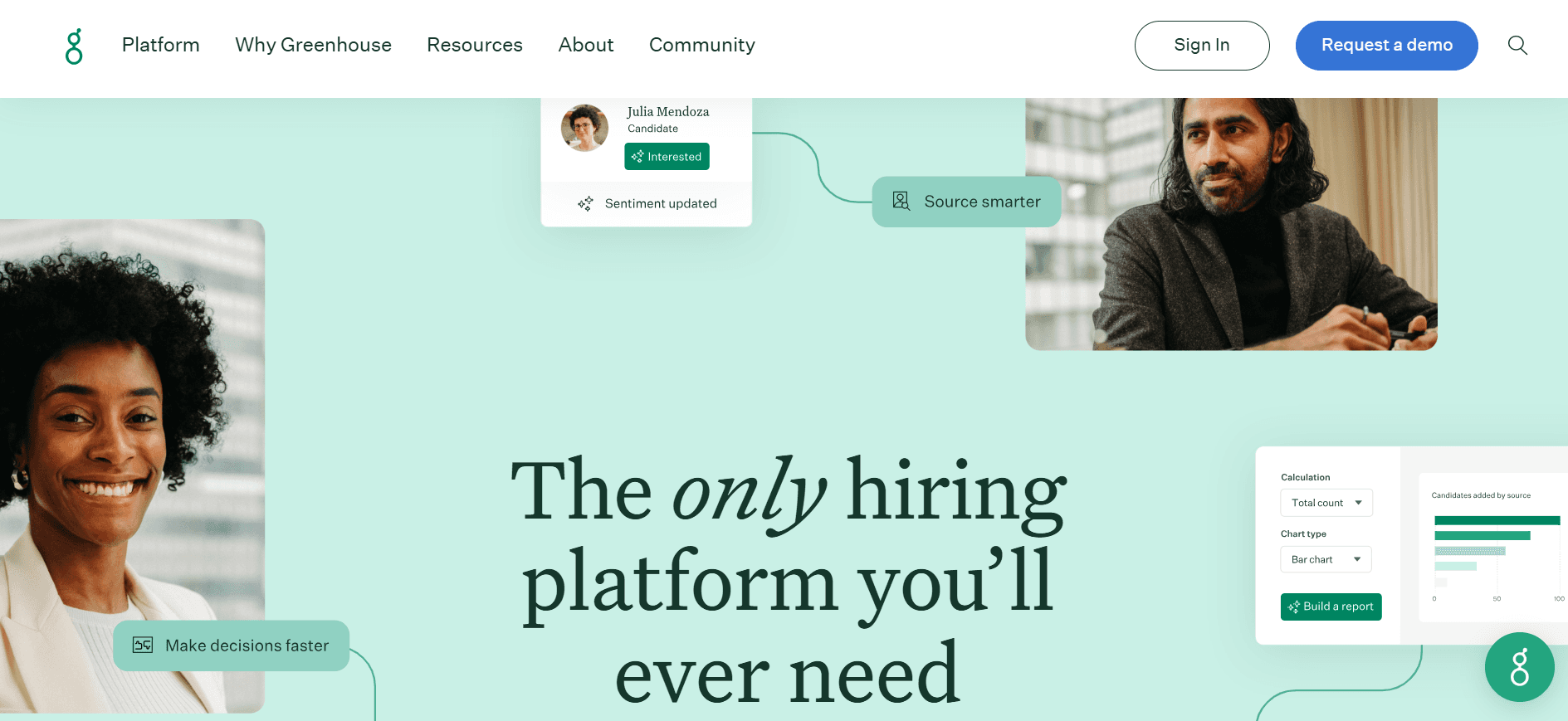
Greenhouse is an ATS built for scalable hiring with customizable pipelines, structured interviews, and strong reporting. It supports complex hiring processes and connects with many HR tools to centralize recruitment and onboarding workflows.
Standout Features
Customizable hiring workflows tailored to roles and teams
Advanced reporting to monitor time-to-hire and sourcing effectiveness
Interview scheduling and collaborative scorecards to improve decisions
Integrations with 200-plus HR tools and onboarding services
Pros
Robust analytics deliver actionable insights into hiring bottlenecks.
Cons
Initial setup can be complex and resource-intensive for small teams.
7. Glassdoor: Employer Brand and Candidate Trust
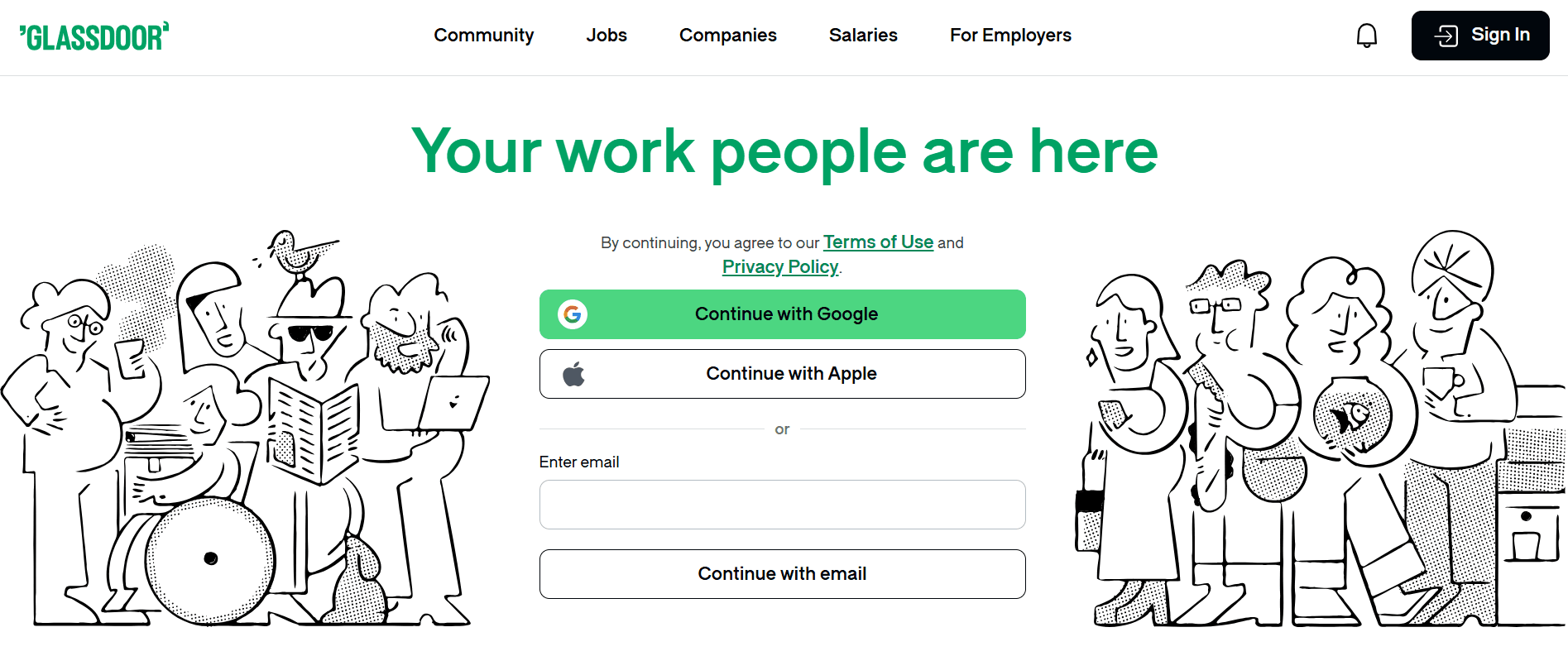
Glassdoor focuses on employer branding and candidate transparency, helping startups surface culture, values, and employee reviews alongside job postings. That combination helps recruit candidates who align with company fit while boosting job visibility through integrated job listings.
Standout Features
Employer branding tools to showcase company culture and values
Candidate and interview reviews that give insight into working life
Analytics to measure brand perception and candidate interest
Bundled options with job boards to extend reach
Pros
Strong employer-branding tools attract candidates aligned with the company culture.
Cons
It can be pricier than other boards and has a narrower candidate pool for some roles.
8. JazzHR: Startup Friendly ATS with Budget Focus

JazzHR offers a straightforward ATS built for startups and smaller teams, combining:
Job distribution
Resume parsing
Simple workflows
It keeps costs low while offering the core automation needed for effective hiring without dedicated HR staff.
Standout Features
Central dashboard to post jobs on multiple boards and manage applicants
Automated resume screening and ranking to accelerate review
Customizable workflows to match hiring processes for different roles
Collaborative feedback features for team decisions
Pros
Simple interface and accessible pricing are ideal for lean startups.
Cons
Reporting can be limited, making it harder to extract advanced insights.
9. ZipRecruiter: Wide Distribution with Smart Matching
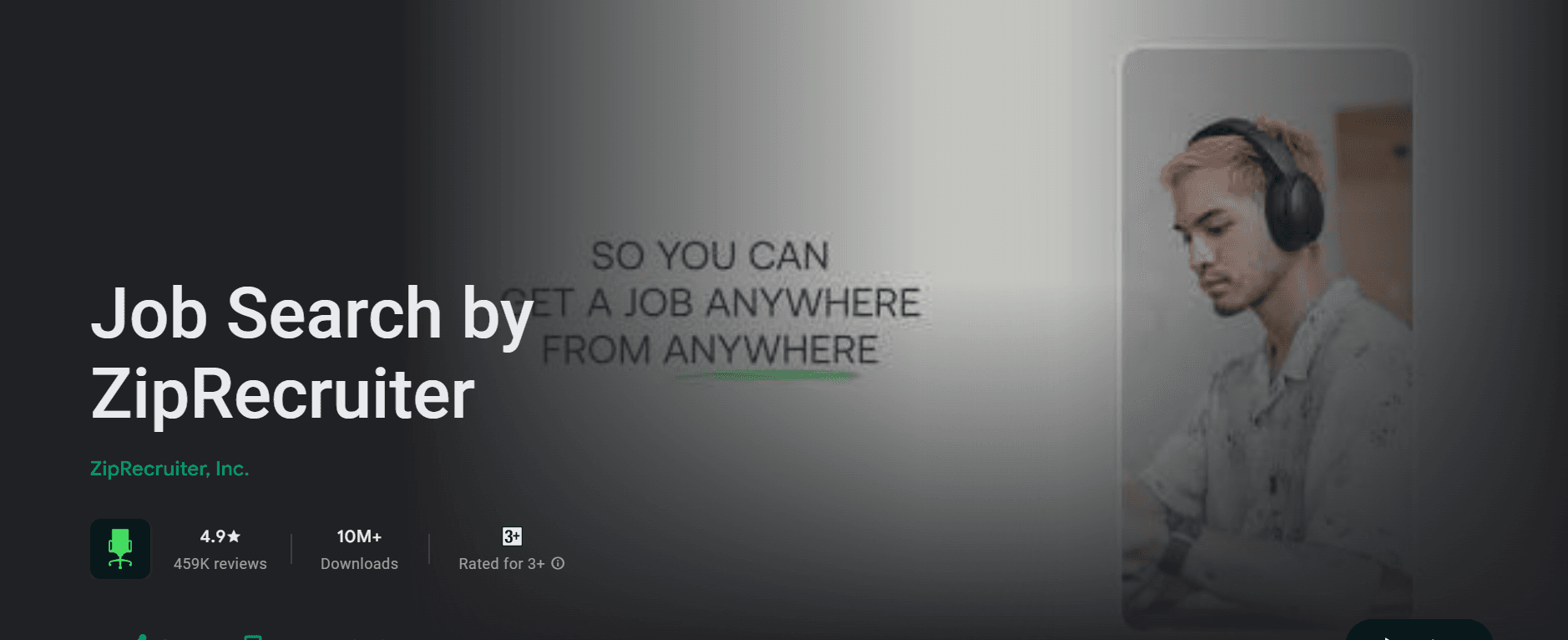
ZipRecruiter amplifies job visibility by syndicating single postings across many job boards and social channels. It's intelligent matching pulls relevant candidates forward, reducing time spent searching and improving pipeline velocity.
Standout Features
One-click distribution across a broad network of boards and channels
AI-powered matching that surfaces relevant candidates quickly
Mobile-first design for candidate and recruiter convenience
Premium support options with phone, email, and chat
Pros
It is excellent for expanding candidate reach promptly with minimal effort.
Cons
Pricing can be higher than competitors', especially for smaller companies.
10. Lever: Collaboration and Bias-Aware Hiring
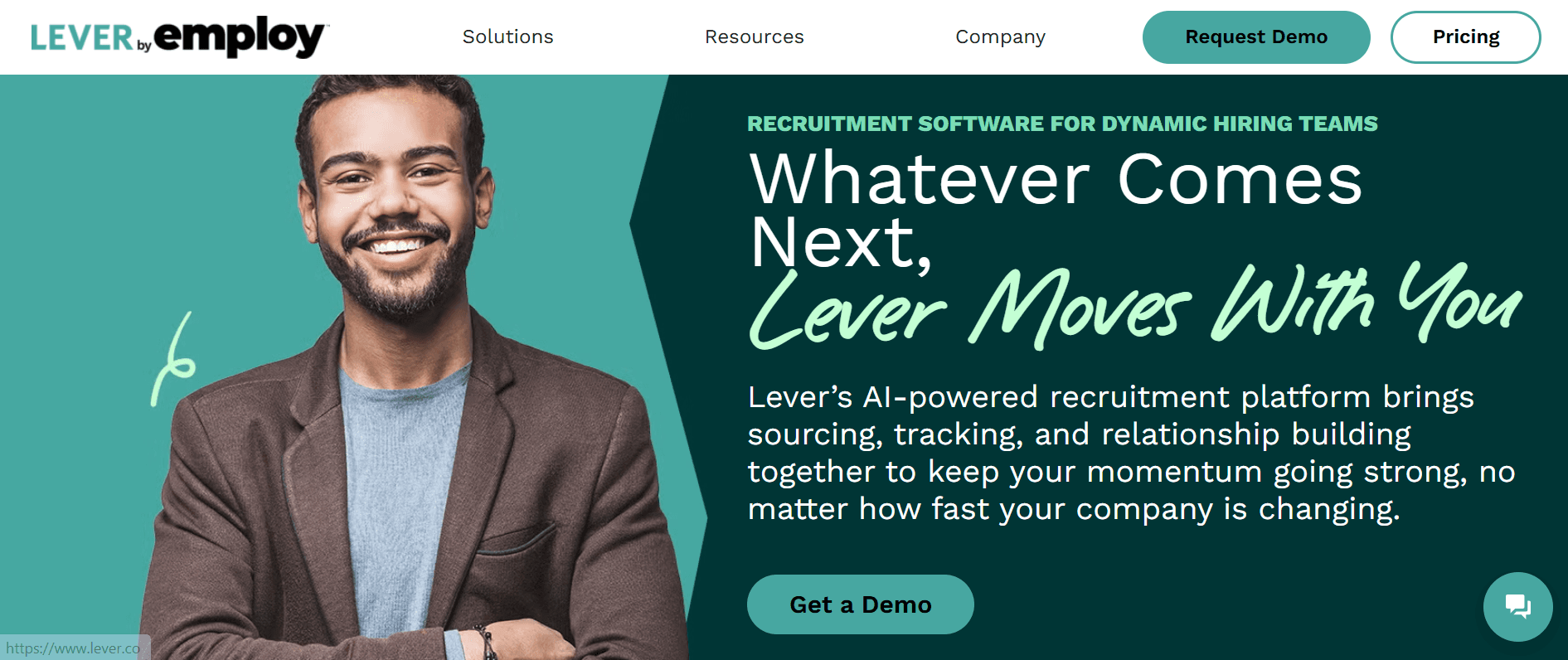
Lever is a collaboration-first ATS that supports structured hiring, shared pipelines, and AI features to standardize interviews. It pairs recruitment marketing and analytics so teams scale hiring while maintaining quality and fairness.
Standout Features
Flexible workflows and collaborative pipelines for team decision making
AI tools to standardize interviews and reduce bias
Recruitment marketing features to attract candidates
Detailed analytics to inform hiring strategy
Pros
Strong collaboration design with automation and reporting for growth.
Cons
Advanced features can overwhelm small teams without HR bandwidth.
11. SmartRecruiters: End-to-End Cloud Hiring
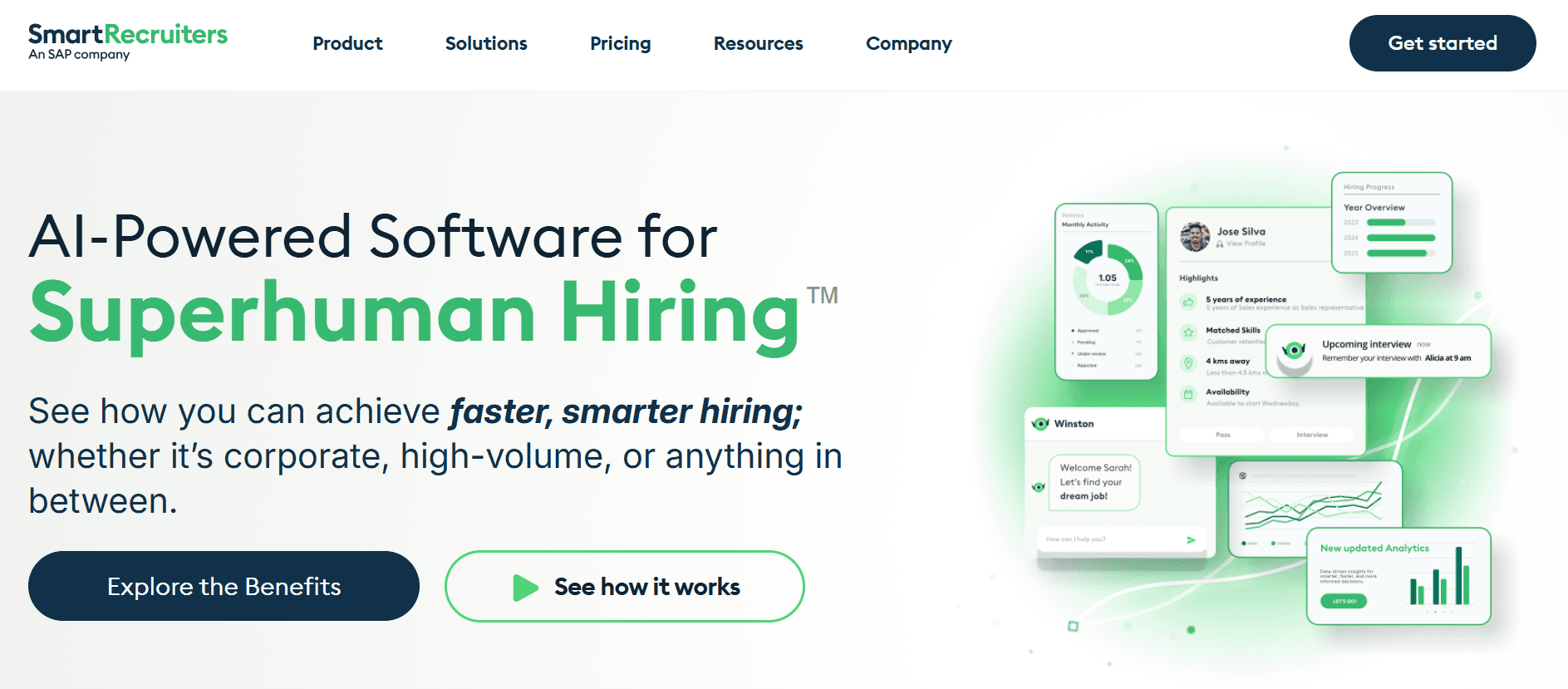
SmartRecruiters offers a cloud-native recruitment platform that covers job posting to onboarding. It uses AI for candidate matching and connects to a broad marketplace of HR tools to scale hiring for growing startups.
Standout Features
End-to-end hiring platform from sourcing to onboarding
AI-driven insights that speed up shortlisting and matching
Marketplace integrations with popular HR and workforce tools
Cloud design for multi-user collaboration across devices
Pros
Intuitive interface reduces time to adopt and use.
Cons
Premium features can increase total platform costs for startups.
12. Dover: Free ATS Plus Fractional Recruiters

Dover combines a free ATS with access to an on-demand marketplace of fractional recruiters who know startup hiring. The platform offers AI candidate scoring, resume ranking, and sourcing extensions to help lean teams use expert recruiters only when needed.
Standout Features
Free ATS with unlimited users and job postings to limit upfront costs
On-demand fractional recruiter marketplace for flexible recruiting support
AI-powered candidate scoring and resume ranking tailored to startups
Sourcing tools, including a LinkedIn extension and automated job posting
Pros
Free core software plus flexible recruiting hours reduce fixed hiring costs.
Cons
Fractional recruiting adds hourly costs that can accumulate for intensive hiring needs.
13. Moonhub: Automated Outreach for Passive Talent
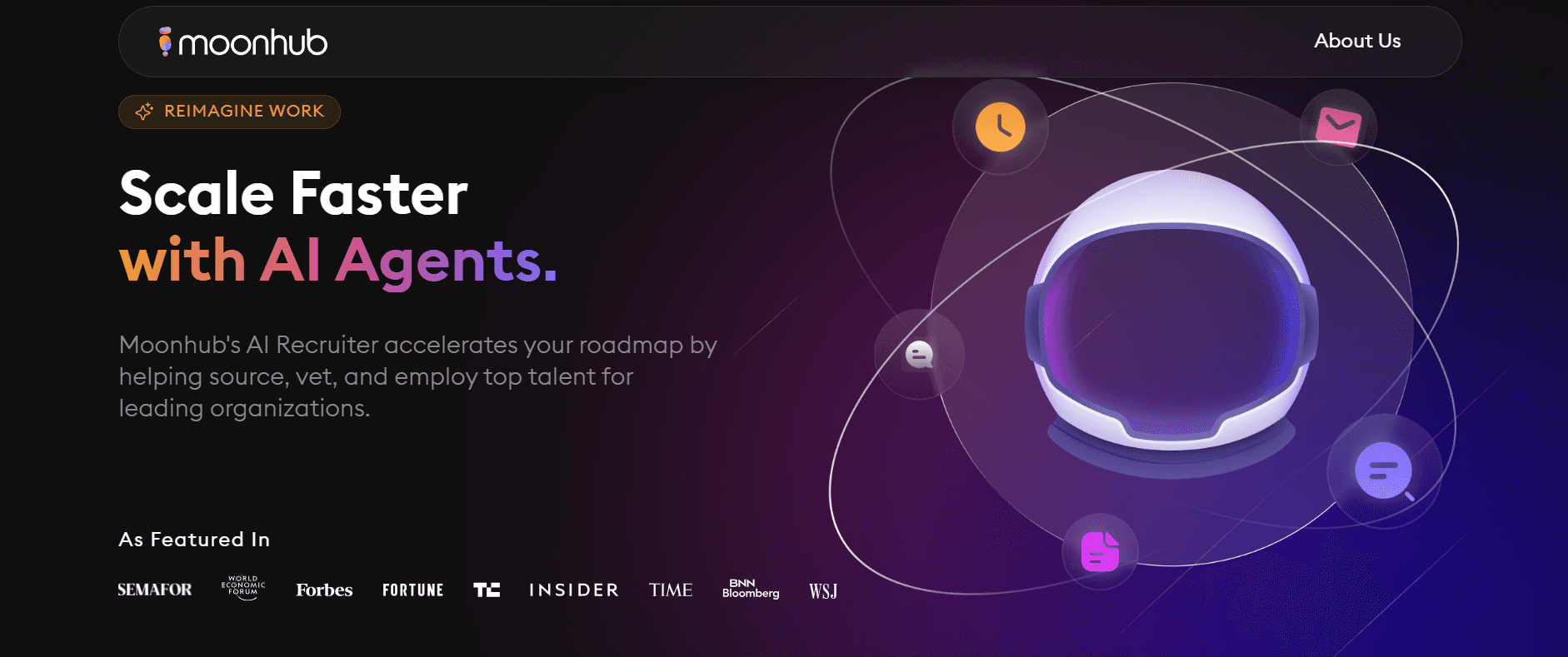
Moonhub applies proprietary AI to:
Source and vet candidates
Focusing on passive talent discovery
Automated engagement
The platform automates outreach and early screening, allowing startups to unlock candidates who are not actively searching while reducing recruiter workload.
Standout Features
AI candidate sourcing and automated screening to speed top-of-funnel work
Automated outreach and candidate engagement to convert passive talent
Recruiting partner support for final evaluation and closing
Emphasis on identifying passive talent with startup skills
Pros
Good at finding passive candidates who match specialized startup roles.
Cons
Requires significant onboarding and setup time before delivering full value.
14. Rocket: Agency with AI-Powered Sourcing
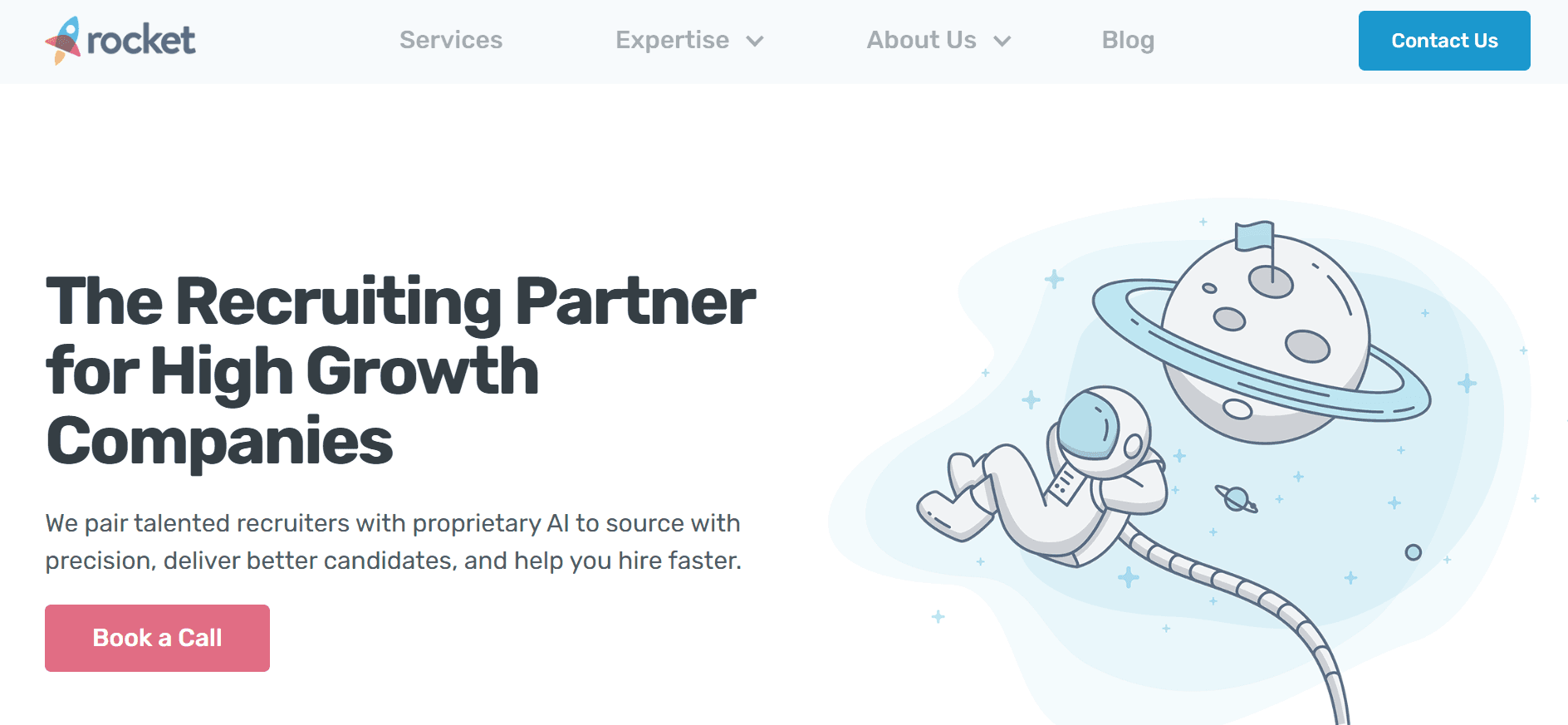
Rocket blends experienced technical recruiters with AI sourcing tools and candidate databases to support embedded or retained hiring models. It suits startups planning sustained growth who want agency-level closing support combined with automated candidate discovery.
Standout Features
Tech-specialized recruiters paired with AI and proprietary sourcing software
Full-service recruiting covering sourcing, screening, and closing
Embedded recruiting teams for ongoing hiring programs
Candidate databases tuned for technical and AI roles
Pros
Strong recruiter expertise for technical hires supported by AI sourcing.
Cons
The agency model requires more extended engagement and higher investment than self-serve platforms.
15. Wellfound: Startup-Focused Job Board Plus Services
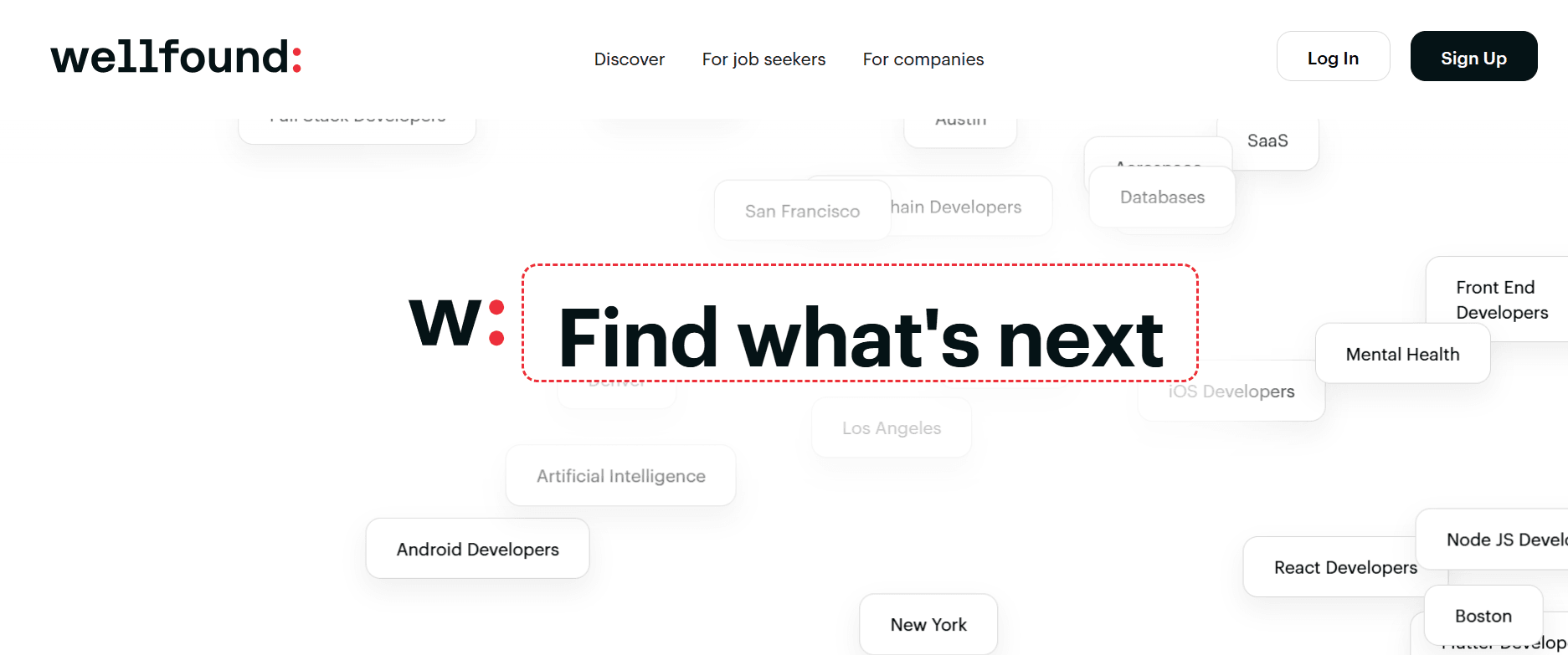
Wellfound centers on startup talent with a job board and optional managed recruiting services. It matches startup-minded candidates to roles using AI candidate matching and provides RecruiterCloud for teams that want hands-on support.
Standout Features
A startup-focused candidate pool that understands early-stage roles
AI-powered matching to surface relevant applicants from the platform
RecruiterCloud managed service for extra recruiting help
Job board tools tailored to startup brand and role needs
Pros
Good fit for startups looking to hire people who prefer startup environments.
Cons
Primarily a job board with limited hands-on recruiting unless you buy managed services.
16. Contrario: Networked Experts for Tough Roles
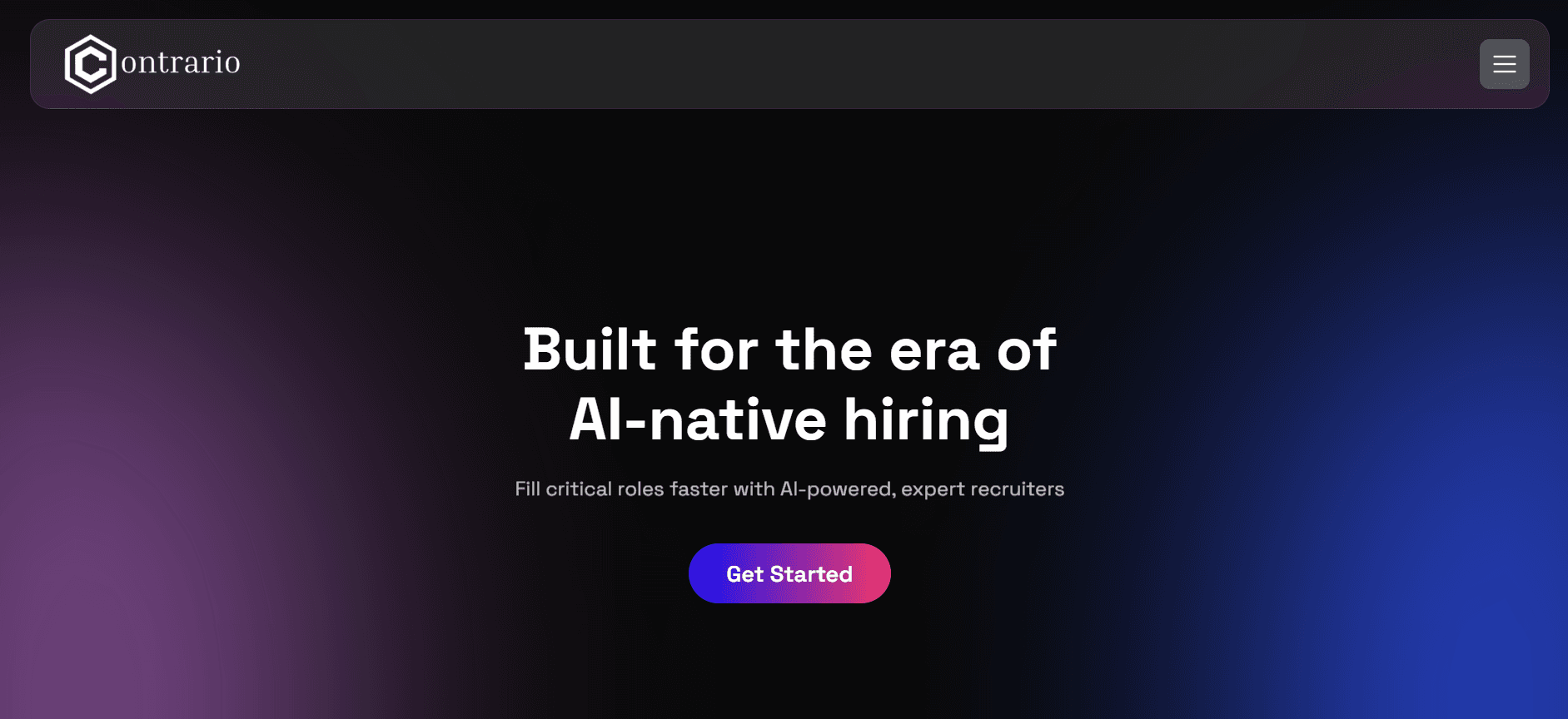
Contrario is a managed hiring network that fills challenging technical roles quickly by combining AI filtering with expert recruiters. The service focuses on complex searches where domain knowledge and candidate vetting are essential.
Standout Features
AI-powered filtering and screening for difficult technical positions
Network of expert recruiters to evaluate deep technical skills
White-glove candidate presentation to reduce screening time for hiring managers
Focus on roles that typically take months to fill
Pros
Effective for challenging technical hires that need a deep domain assessment.
Cons
Best suited to growth-stage companies and may not fit early-stage budgets.
17. Manatal: Global Reach and AI Recommendations
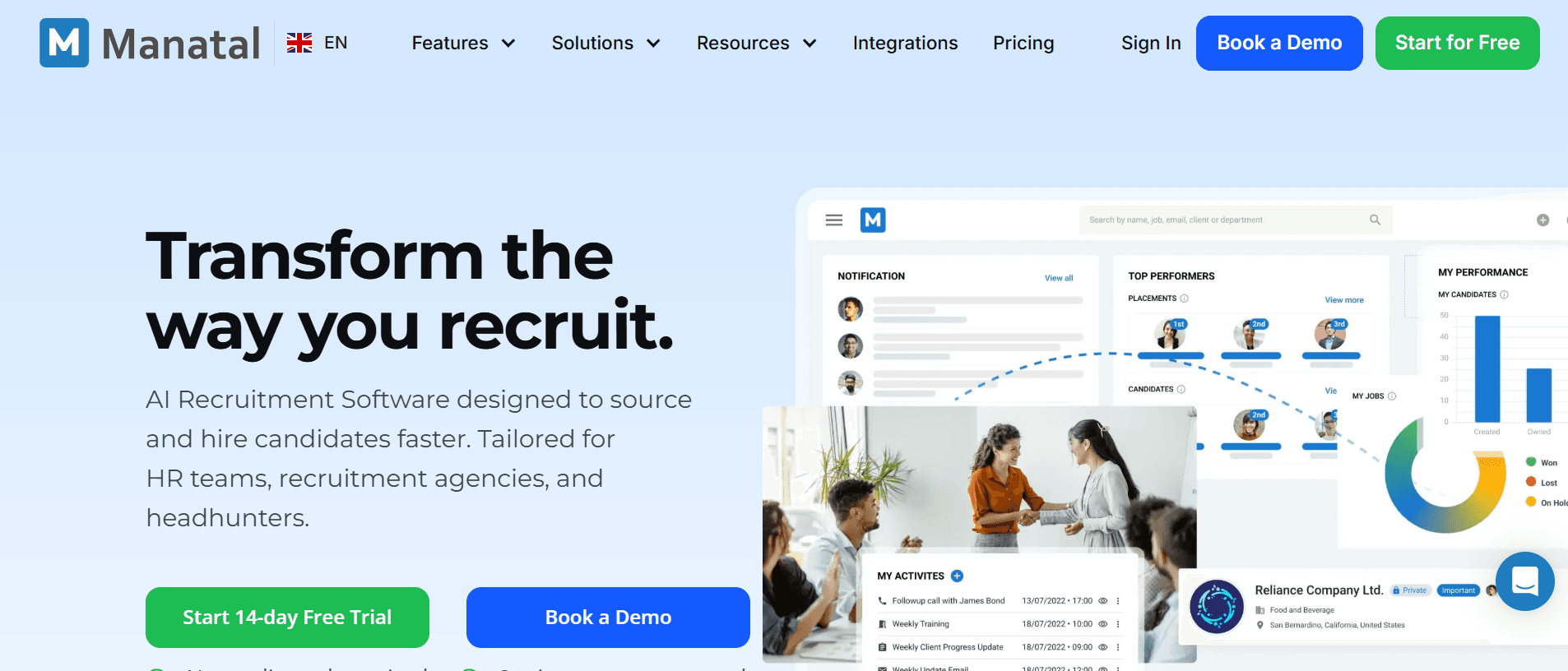
Manatal is an AI-powered ATS and recruitment CRM that centralizes sourcing from thousands of channels and recommends best-fit candidates instantly. It supports global hiring with analytics, compliance tools, and an AI recommendation engine that speeds candidate discovery.
Standout Features
Centralized sourcing from 2,500-plus free and premium channels
An AI recommendation engine that surfaces best-fit candidates within seconds
Integrated ATS and recruitment CRM for candidate lifecycle management
In-depth analytics and compliance tools for global teams
Pros
Broad sourcing channels and fast AI recommendations improve recruiter efficiency.
Cons
Feature depth can overwhelm teams that only need basic ATS functions.
18. Fetcher: Blend of AI Sourcing and Human Curation
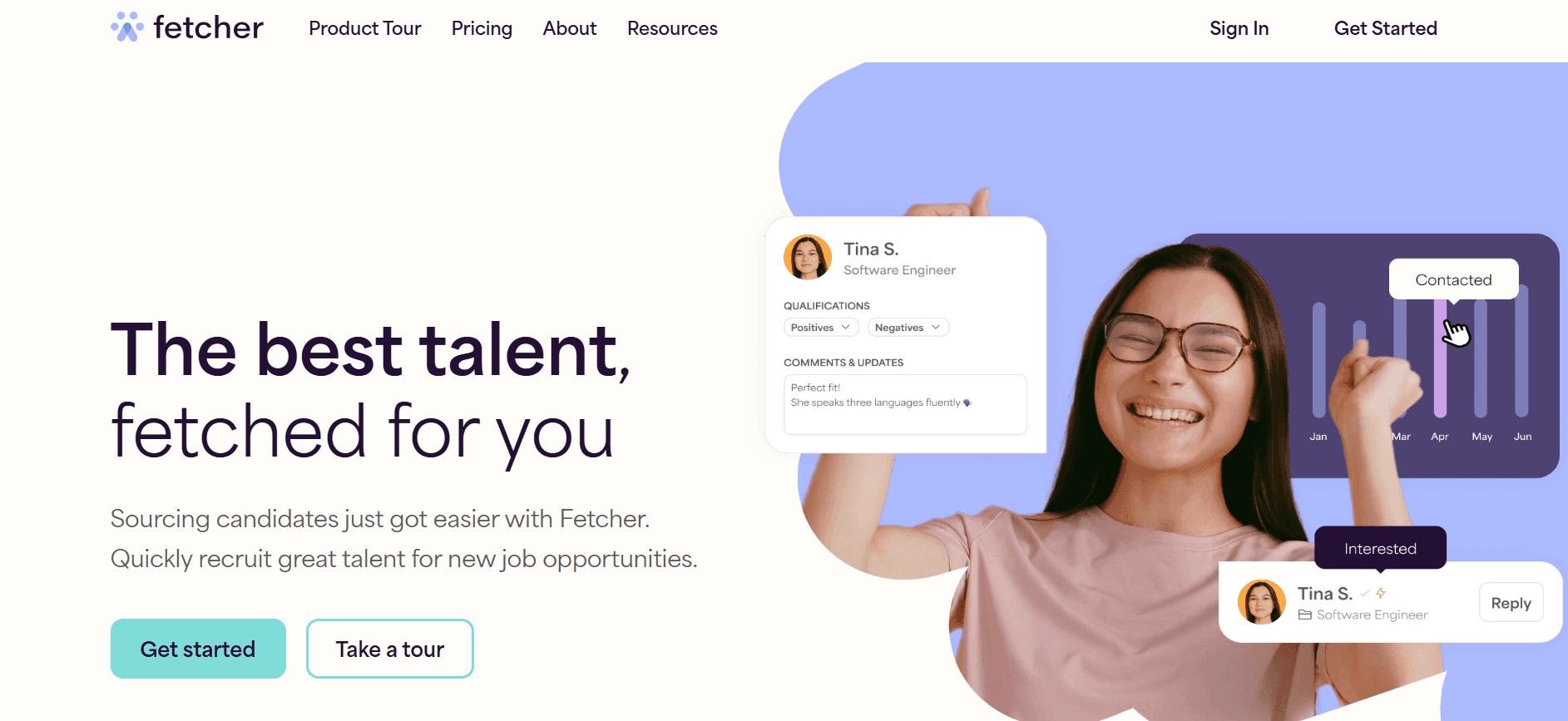
Fetcher combines AI-driven sourcing with human oversight to automate outreach and surface high-quality candidates. It integrates with ATS and communication tools to run personalized email campaigns that track engagement and improve pipeline conversion.
Standout Features
AI plus human sourcing model to find and qualify candidates
Integrations with ATS, email, calendar, and Slack for smooth workflows
Personalized automated email campaigns with engagement tracking
Recruitment analytics to measure diversity, engagement, and efficiency
Pros
Balances automation and human judgment to improve sourcing accuracy.
Cons
Human-curated models raise costs compared with fully automated tools.
19. Entelo: Diversity-Driven Source to Hire Automation

Entelo offers source-to-hire automation that helps teams find diverse and passive talent using predictive analytics and outreach recommendations. The platform adds managed service options for teams that want strategic recruiting help alongside automation.
Standout Features
Advanced candidate search across deep databases with predictive signals
Career and propensity insights to find candidates likely to move
Data-driven recruitment messaging suggestions to boost response rates
Managed service team to support strategic hiring needs
Pros
Strong focus on diversity and passive candidate engagement with compliance features.
Cons
Premium features and managed services can be costly for smaller startups.
20. Paradox: Conversational Recruiting at Scale
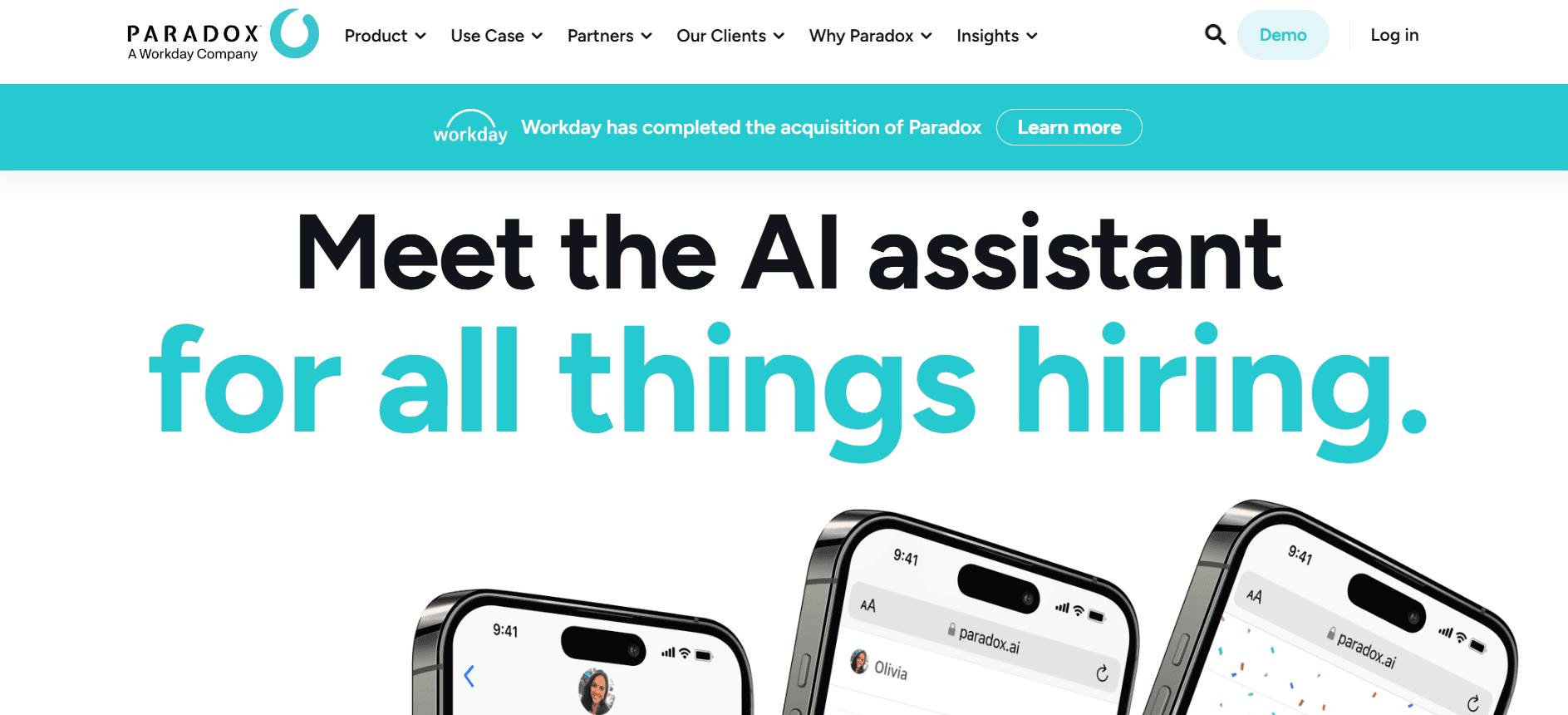
Paradox uses a conversational AI assistant to automate screening, scheduling, and candidate questions, making it ideal for high-volume hiring. The platform supports unique apply flows like text-to-apply and QR code applications to reach on-the-go candidates.
Standout Features
Conversational recruiting assistant for screening, scheduling, and onboarding
Instant job matching and text-to-apply or QR code application options
Automated screening via candidate-preferred messaging channels
AI-driven offer and onboarding automation to speed hiring completion
Pros
Excellent for high-volume roles where conversational automation reduces manual work.
Cons
This is best for industries with volume hiring patterns; smaller hiring programs may underutilize features.
21. Skillate: Job Description and Matching Intelligence
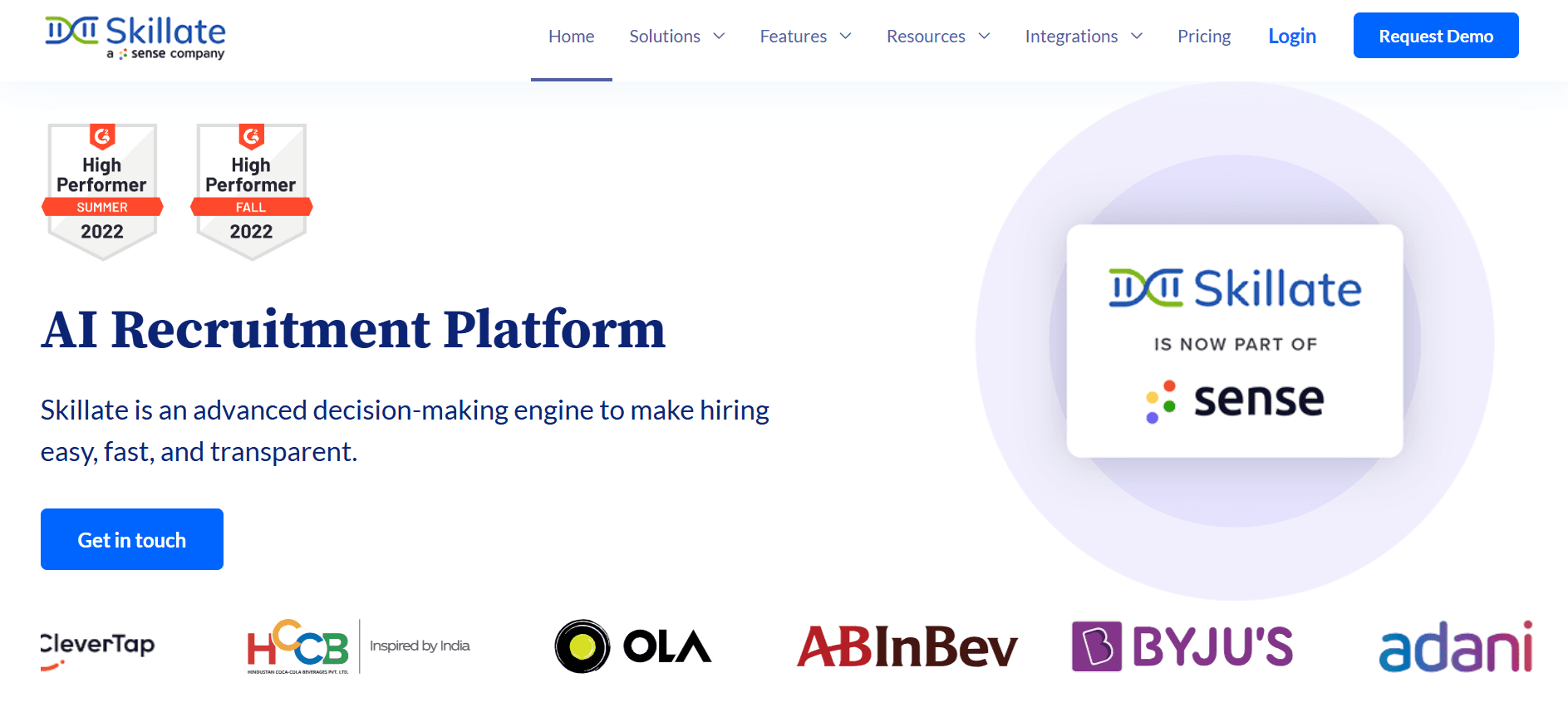
Skillate combines job description optimization with AI candidate matching to enhance fit and speed. Its platform uses machine learning to map full resume content to roles, reducing false negatives from keyword searches and supporting diverse hiring goals.
Standout Features
Intelligent job description assistant leveraging millions of job signals
AI candidate matching that reads full resume context beyond keywords
Chatbot screening to reduce manual pre-screen calls
Analytics dashboards tracking pipeline health and channel quality
Pros
Improves candidate fit by moving beyond keyword matching to contextual AI.
Cons
Advanced matching may need tuning to local job market nuances.
22. Teamtailor: Candidate-Centric Hiring with Generative AI
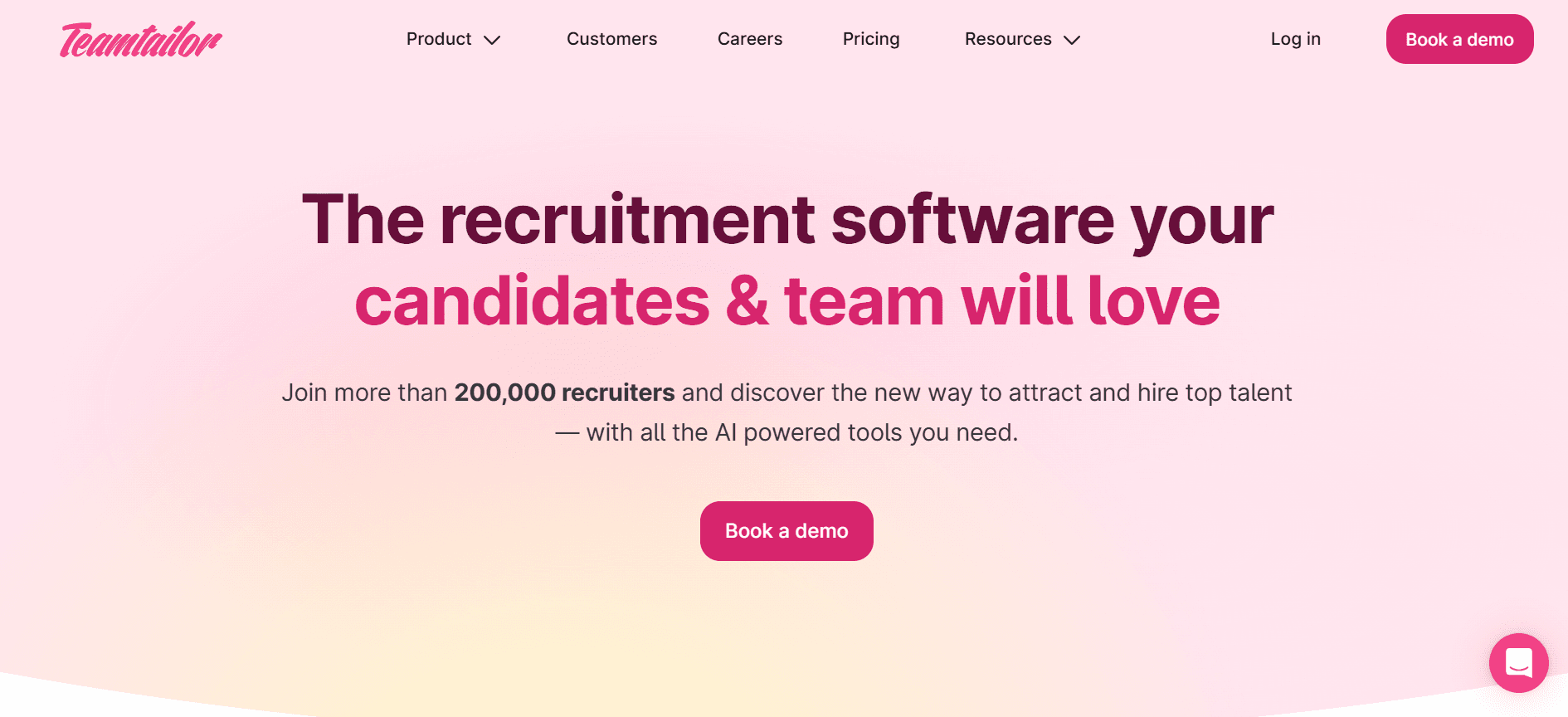
Teamtailor offers candidate-focused recruitment software with a generative AI assistant that writes job posts, drafts interview questions, and summarizes resumes. It automates smart triggers and analytics to keep pipelines proactive and maintain a positive candidate experience.
Standout Features
Generative AI co-pilot for job posts, interview guides, and candidate messages
Collaboration tools to centralize feedback and standardize interviews
Smart triggers for pipeline movements, scheduling, and communications
Advanced analytics to uncover pipeline improvements and security oversight
Pros
Candidate-centered features and AI co-pilot reduce time spent on content and coordination.
Cons
Reliance on generative AI may require careful review to maintain brand voice.
23. ClearCompany: Talent Management Across the Employee Lifecycle
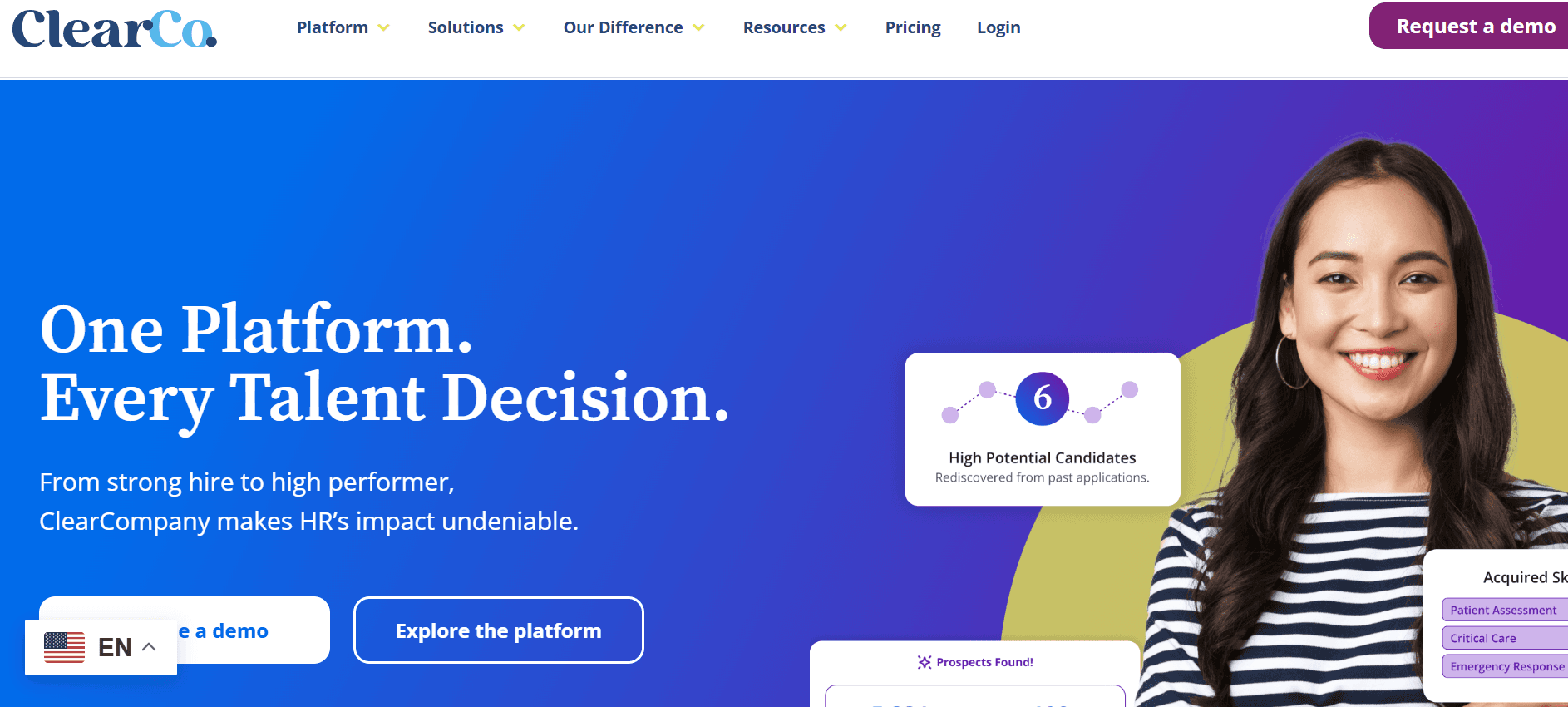
ClearCompany combines an AI-assisted ATS with onboarding and performance tools to manage the full employee lifecycle. It uses AI to screen for attributes that align with top performers and automates recruitment campaigns to keep pipelines engaged.
Standout Features
AI-assisted ATS that matches candidates to profiles of top performers
Automated recruitment campaigns across email and text channels
Virtual onboarding tools and lifecycle automation
Reporting on recruiting, performance, turnover, and compensation
Pros
Integrated talent management connects hiring with performance and retention.
Cons
The Full suite can be more than smaller teams need and may increase costs.
24. Textio: Inclusive Job Writing and Hiring Language

Textio analyzes job descriptions and other recruitment content to flag biased or ineffective language and suggest inclusive alternatives. Its scoring predicts the diversity of your candidate pool and helps recruiters write messages that perform better across audiences.
Standout Features
Predictive score that forecasts candidate diversity for each job description
Library of optimized job templates to accelerate inclusive content creation
Performance reports for feedback quality and bias in reviews
Integrations with LinkedIn, ATS, and email to embed language insights
Pros
Improves candidate quality and diversity by optimizing job copy and messaging.
Cons
Focused on language; it does not replace sourcing or ATS functionality.
25. HireVue: Automated Interviews and Assessments
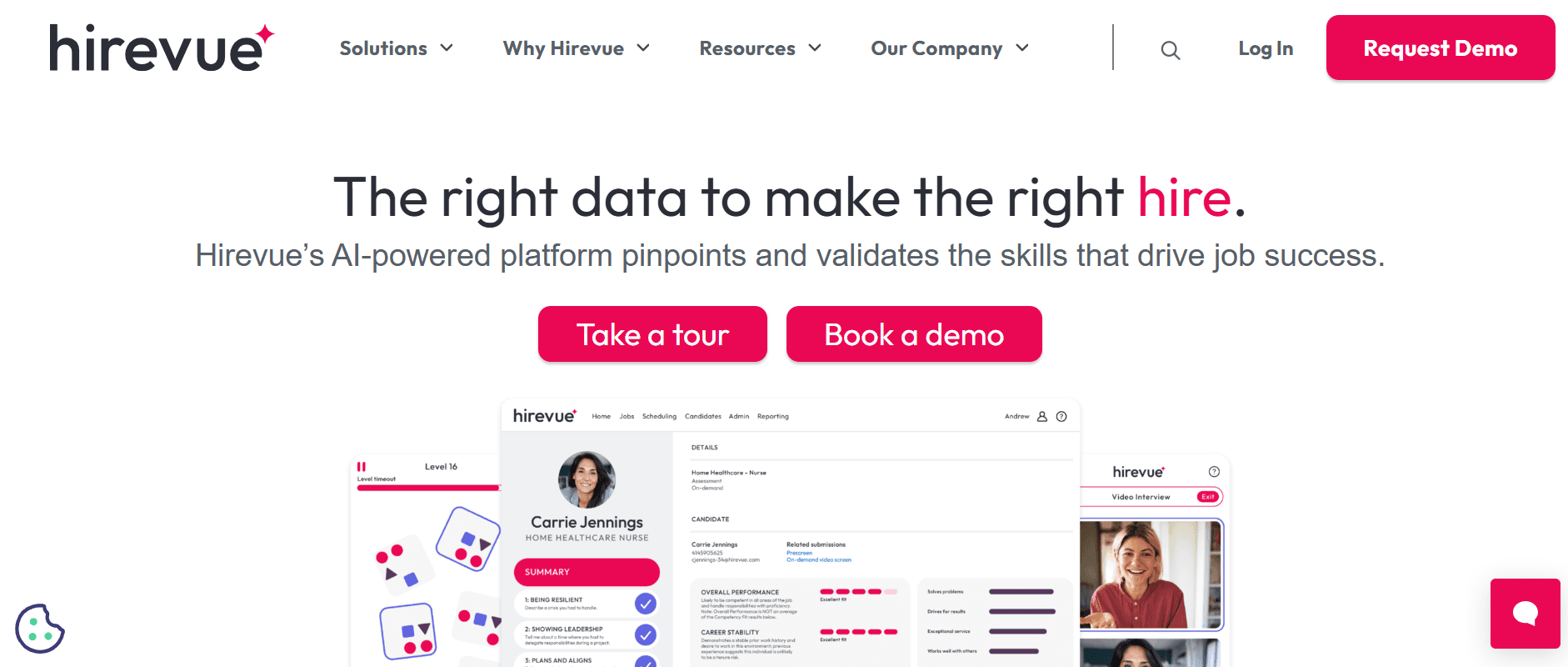
HireVue automates candidate routing and communications with:
AI-driven matching
Chat-based job discovery
Assessments
It scales interviews and screening through game-based, technical, and structured interview tools that aim to make early evaluation faster and fairer.
Standout Features
Chat-based job matching and recruitment automation for rapid screening
Game-based and technical assessments to reveal candidate skills
Integrated text messaging for candidate engagement and reengagement
Interview automation with structured question banks and evaluation guides
Pros
Speeds early screening while standardizing evaluation across candidates.
Cons
Video and assessment features may raise privacy and fairness questions that require governance.
26. EVA: Conversational HR and Candidate Engagement
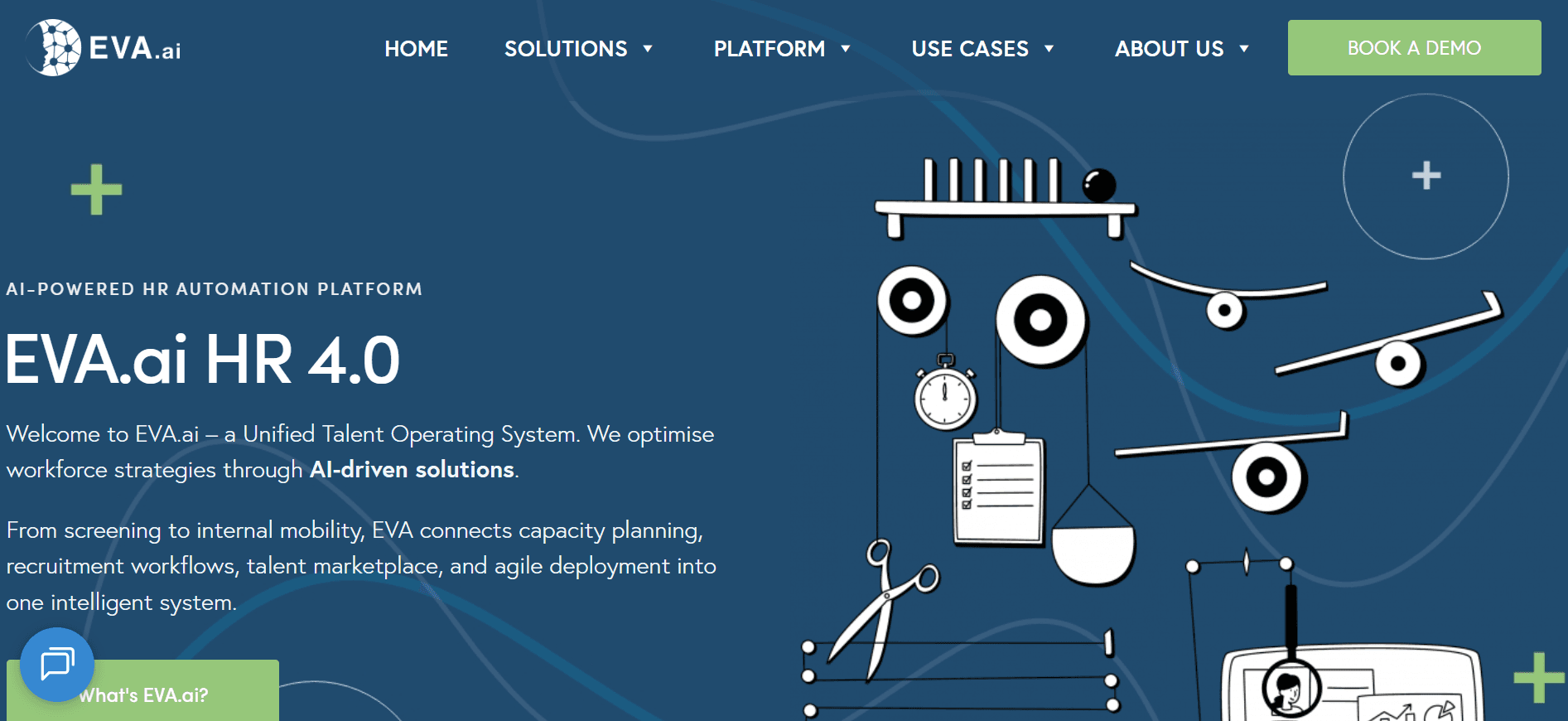
EVA is a conversational AI platform that automates HR and recruiting workflows, from sourcing to onboarding and engagement. It uses conversational bots and predictive matching to maintain candidate and employee interactions around the clock.
Standout Features
Conversational AI assistant for 24/7 candidate and employee questions
Predictive talent matching based on skills and interests
People analytics for workforce planning and recruitment metrics
Automated workflows to maintain compliance and manage documents
Pros
Centralizes HR and recruiting automation with conversational touchpoints.
Cons
A broad HR scope may be more than a small recruiting team needs initially.
27. Eightfold: Skills-First Talent Intelligence
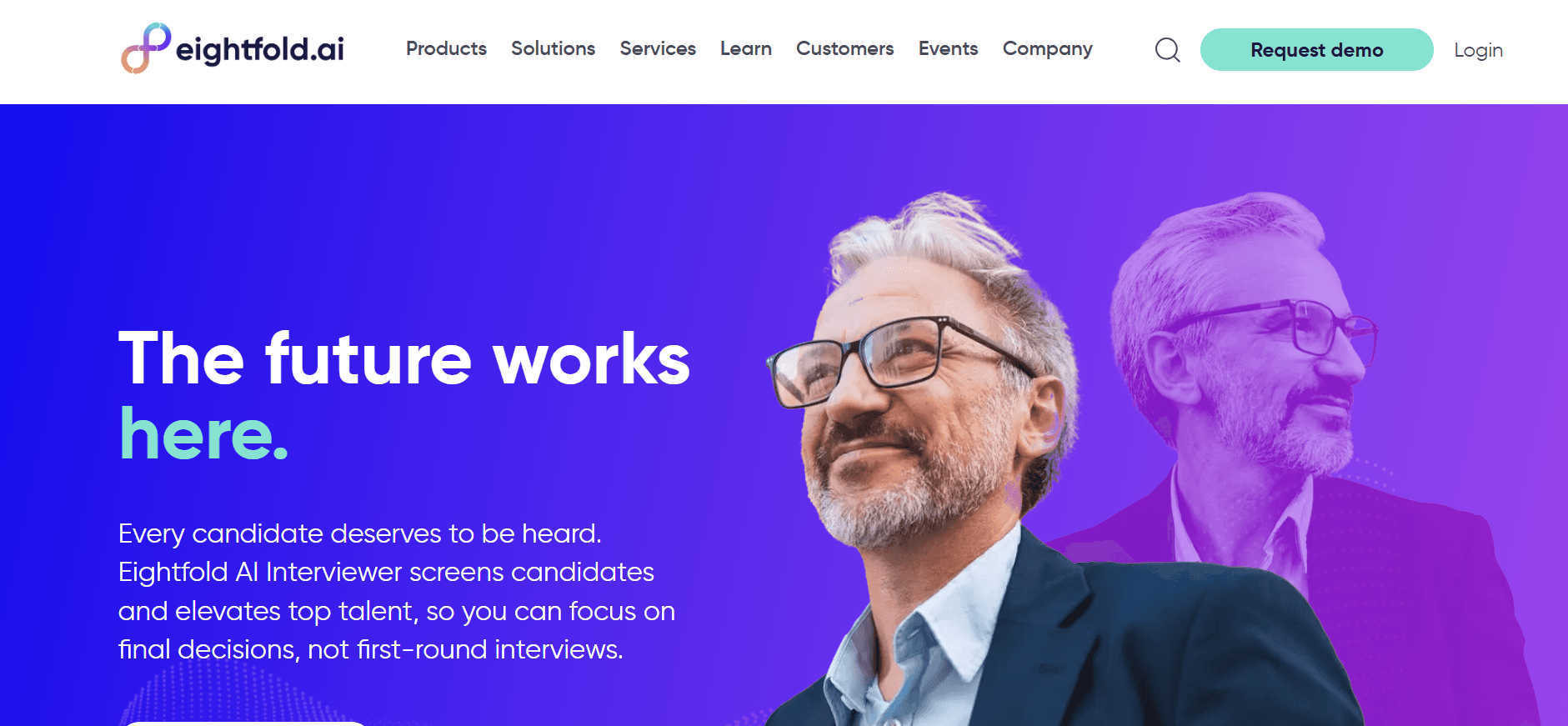
Eightfold is a talent intelligence platform that applies deep learning to match skills and potential across:
Hiring
Internal mobility
Upskilling
It masks personal data to focus on skills and career potential while providing global talent insights for inclusive hiring.
Standout Features
Central talent intelligence for acquisition, management, and skills development
Deep learning that matches based on skills rather than just titles
Career planning and upskilling pathways to improve retention
Global data and compliance frameworks for secure, ethical AI use
Pros
Skills-driven matching helps hire and retain talent by focusing on potential.
Cons
Enterprise scale and feature breadth can be more than early-stage teams need.
28. Humanly: Conversational Screening for Volume Hiring
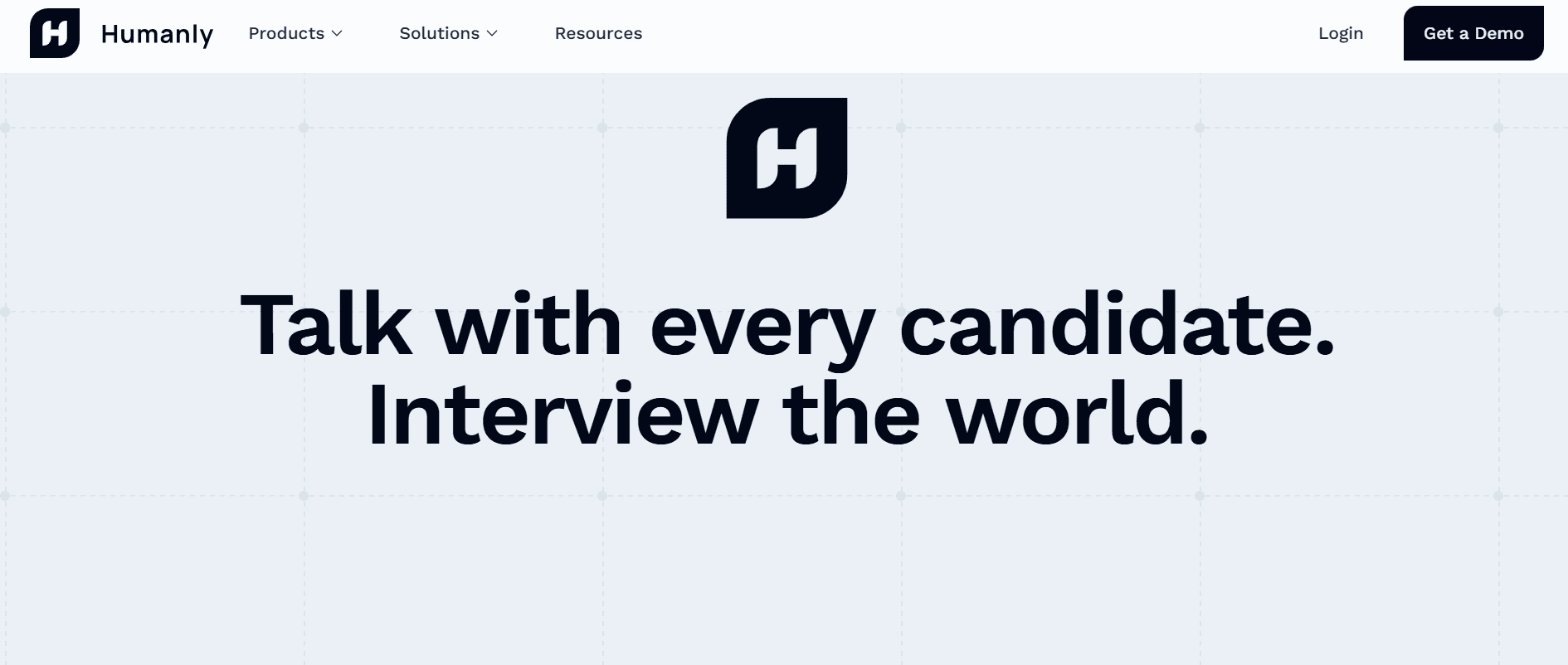
Humanly uses conversational AI to screen candidates at scale, schedule interviews, and manage follow-ups while syncing with ATS systems. It adds AI note-taking and analytics to improve candidate experience and recruiter effectiveness in high-volume pipelines.
Standout Features
AI co-pilot for automated screening, scheduling, and follow-up
AI note-taking during video interviews for faster evaluation
Analytics on candidate interactions to improve conversion and experience
Integrations with engagement tools to tie recruiting to culture insights
Pros
Reduces manual screening time and improves candidate care for volume roles.
Cons
High-volume focus may underdeliver value for low-frequency, senior hires.
29. hireEZ: Large-Scale Candidate Reach and Integration
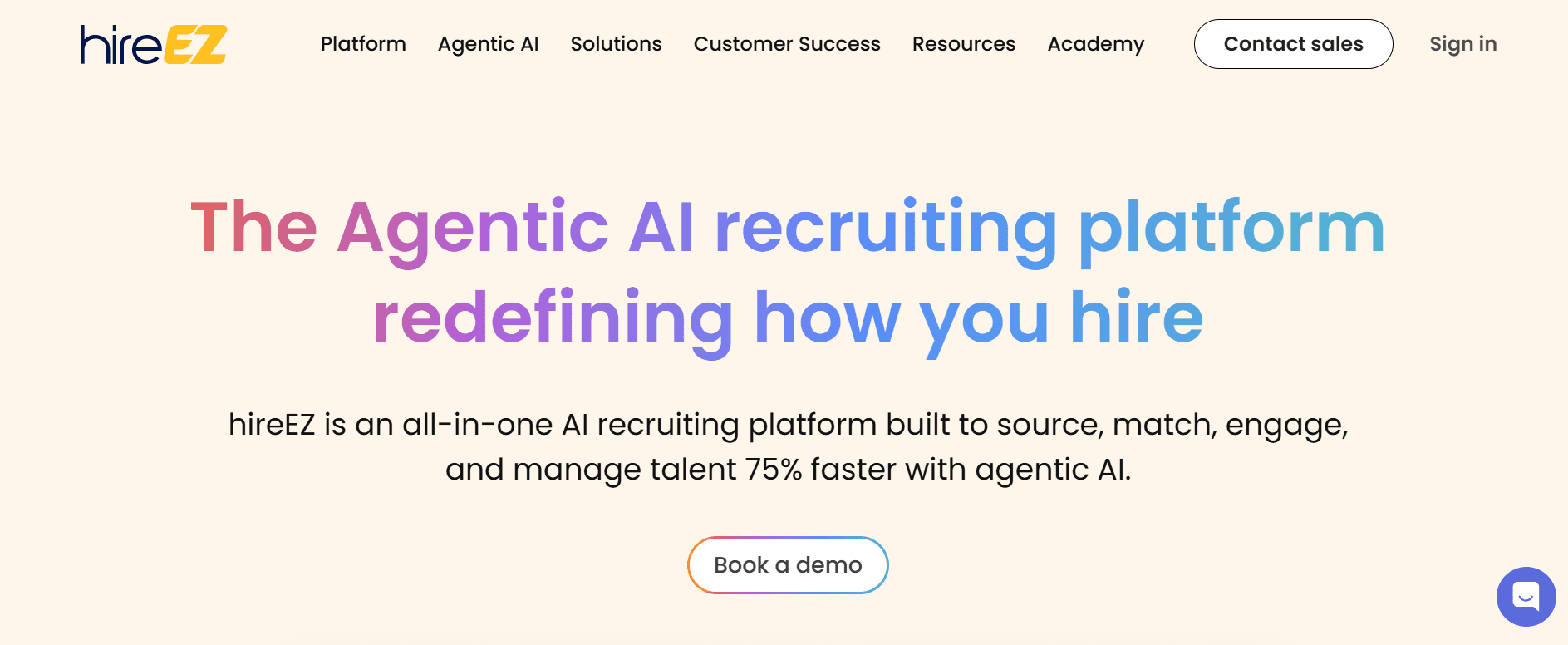
hireEZ provides broad candidate reach and AI-driven search to build pipelines at scale, pairing strong integrations with ATS systems and engagement automation. It centers on fair AI principles and offers market insights to help recruiters make informed sourcing decisions.
Standout Features
AI search to find qualified, diverse talent aligned with skills needs
Integrations with 30-plus ATS systems to streamline workflow
Automated scheduling, email campaigns, and real-time candidate notifications
Market insights and analytics for data-driven sourcing strategy
Pros
Extensive reach and strong integrations make it a go-to for scalable sourcing.
Cons
Platform complexity may require onboarding and process changes.
30. SeekOut: Deep Talent Signals and Rediscovery

SeekOut aggregates extensive candidate profiles and offers AI co-pilot tools for refined searching and diversity insights. It enables the rediscovery of talent from past candidates and provides market intelligence to help teams close hard-to-fill roles.
Standout Features
AI co-pilot for targeted candidate searches using complex filters
Data-driven insights for underrepresented talent and bias mitigation
Automated applicant review to speed resume screening
Talent rediscovery to re-engage previous candidates and reduce time to hire
Pros
Rich candidate signals and rediscovery features improve pipeline quality.
Cons
High data depth can make the platform costly for small hiring volumes.
31. Arya: Talent Intelligence with Automated Sourcing
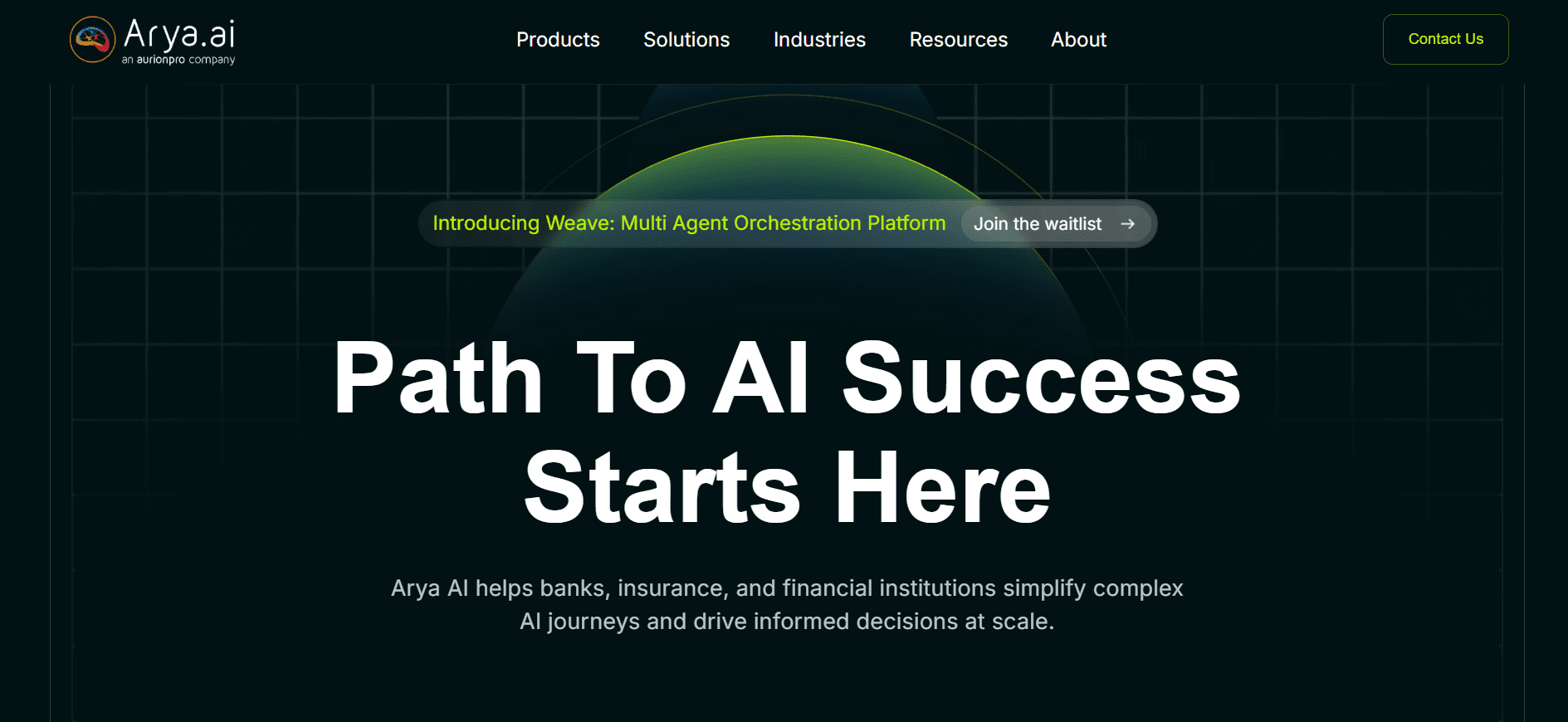
Arya combines AI and talent intelligence to automate sourcing and prioritize candidates based on likelihood to succeed. It integrates with many ATS and CRM platforms to keep pipelines fresh and uses market data to inform compensation and skill distribution.
Standout Features
Automated sourcing from 80-plus channels to build lists quickly
AI candidate ranking to prioritize by success likelihood
Integrations with 60-plus ATS and HR systems for data flow
Talent rediscovery and automated nurture campaigns for past candidates
Pros
Rapid candidate list building and market intelligence help recruiters move faster.
Cons
Broad channel coverage requires tuning to avoid noisy results.
32. Interviewer.ai: Video-Based Prescreening with Generative AI
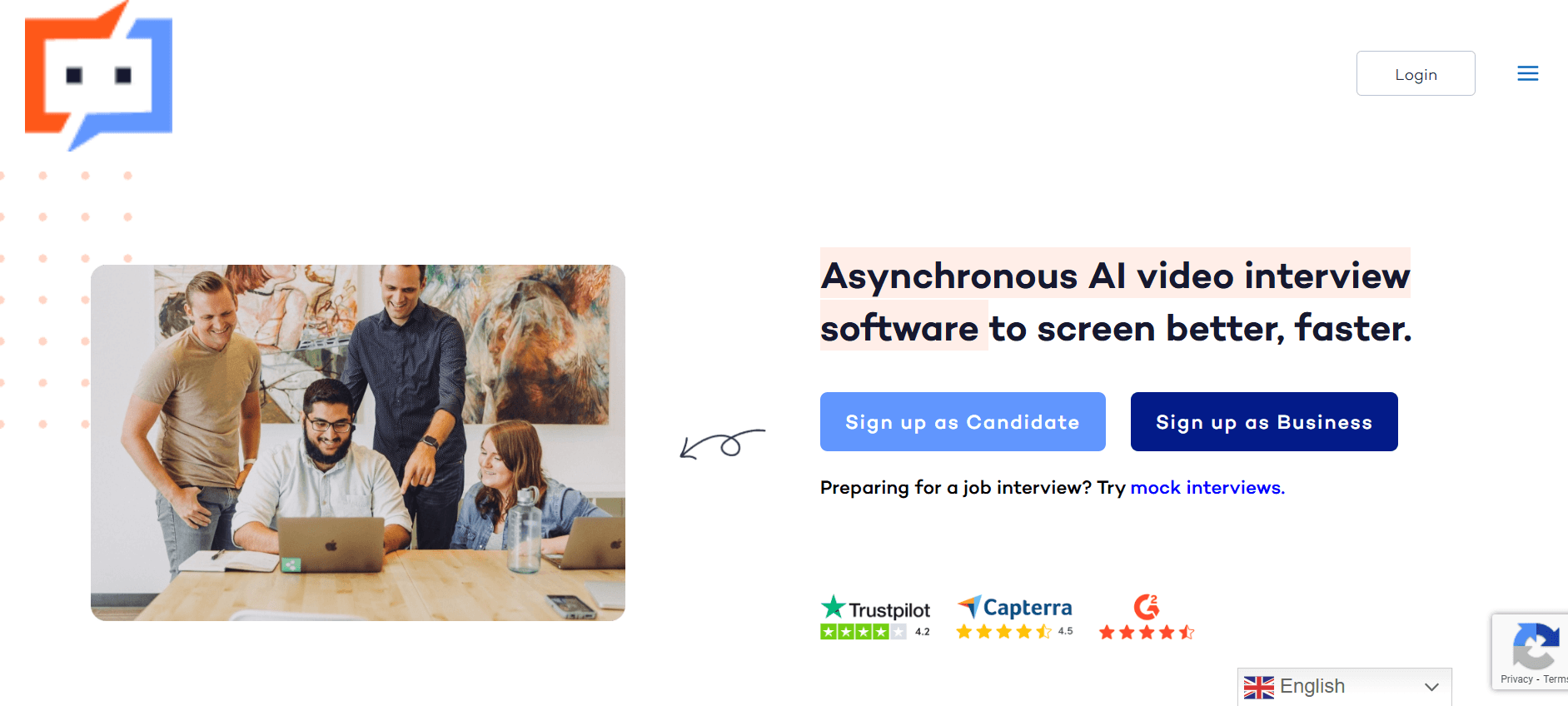
Interviewer.AI uses AI video assessments to prescreen and shortlist candidates while generating job descriptions and interview questions. The platform evaluates communication, motivation, and cultural fit to reduce initial interview time and provide structured candidate profiles.
Standout Features
AI video hiring technology to assess communication and culture fit
Automated prescreening that maps resumes to job requirements
Detailed candidate profiles with evaluative metrics for faster decisions
Collaboration tools for shared feedback and alignment
Pros
Cuts time spent on initial interviews and provides uniform prescreen metrics.
Cons
Video assessments require candidate buy-in and careful bias oversight.
33. Findem: Unified Outbound and Inbound Talent Platform
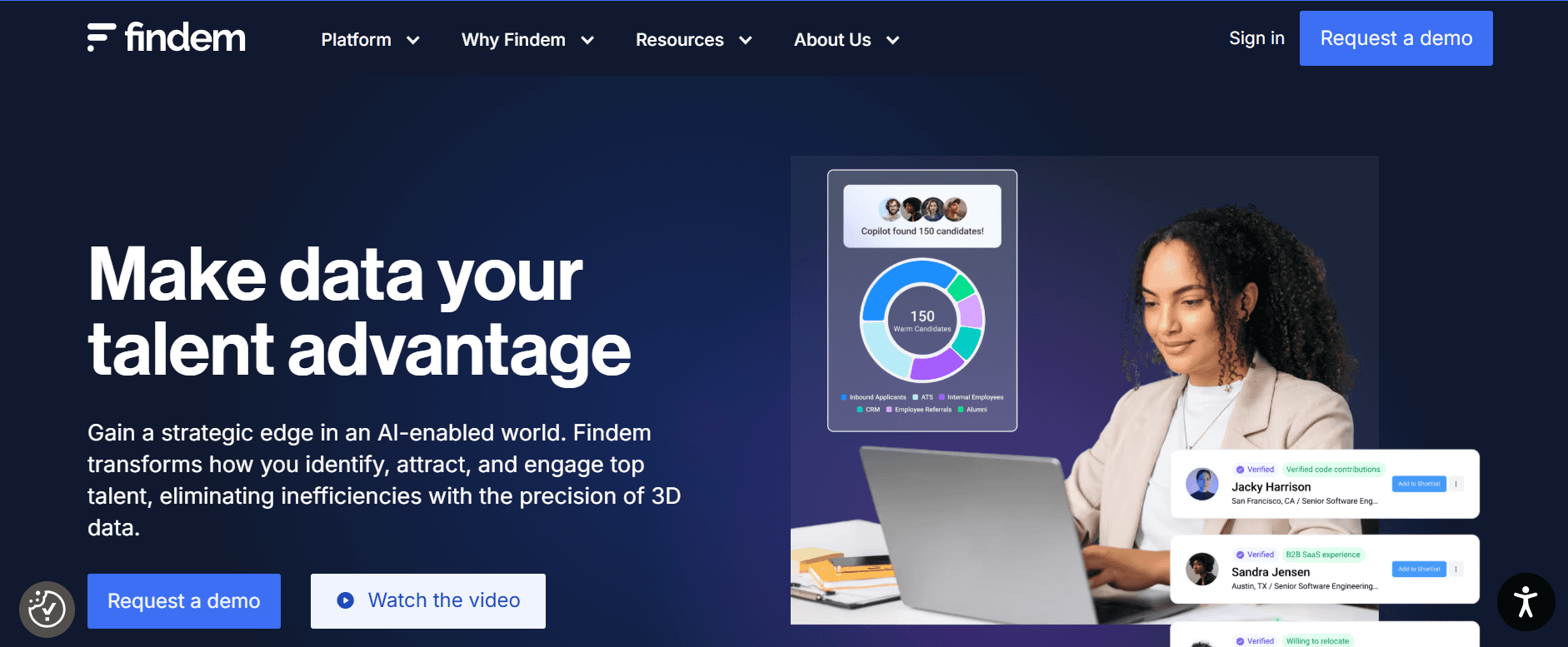
Findem consolidates under AI-driven controls:
Outbound sourcing
Inbound candidate management
Talent rediscovery
It builds diverse talent pools, personalizes outreach, and measures campaign performance to optimize outbound recruiting ROI.
Standout Features
AI-driven talent pools and personalized outreach for outbound sourcing
Generative AI assistant for conversational analytics and search queries
Automated candidate reviews and prebuilt analytics dashboards
Outreach analytics to identify high-performing outbound campaigns
Pros
Strong for teams that run targeted outbound sourcing programs.
Cons
Success depends on data quality and initial model configuration.
34. Beamery: Talent Lifecycle and TalentGPT
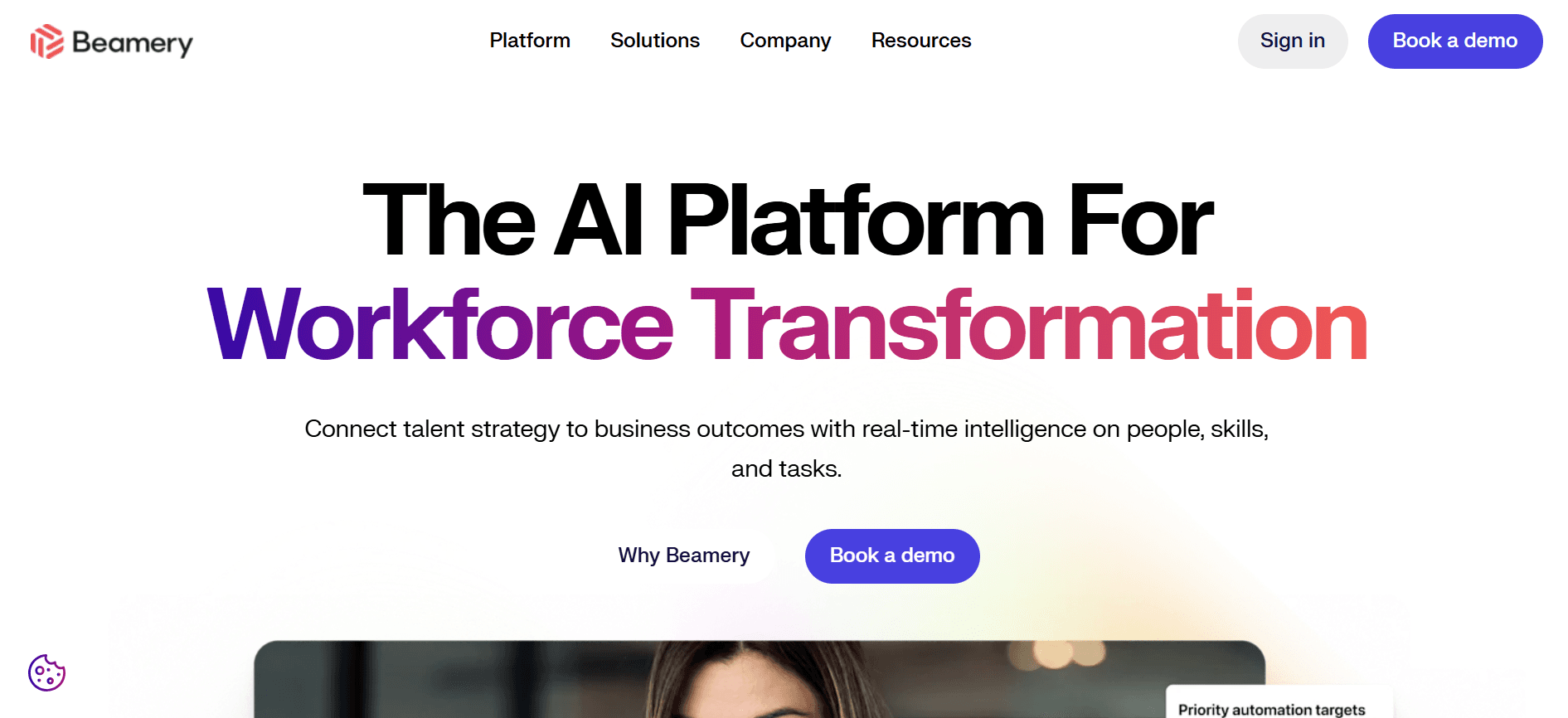
Beamery focuses on talent lifecycle management and introduces TalentGPT to create personalized candidate and employee experiences. The platform provides skills intelligence and proactive pipeline building to help companies hire and retain talent systematically.
Standout Features
Real-time talent lifecycle insights and skills intelligence
TalentGPT for generative, personalized candidate and manager interactions
AI candidate recommendations based on skills and potential
Integrated career-pathing and internal mobility tools
Pros
Connects recruiting with long-term talent development and retention.
Cons
Enterprise features may be excessive for teams focused only on hiring.
35. HiredScore: Responsible AI for Talent Matching
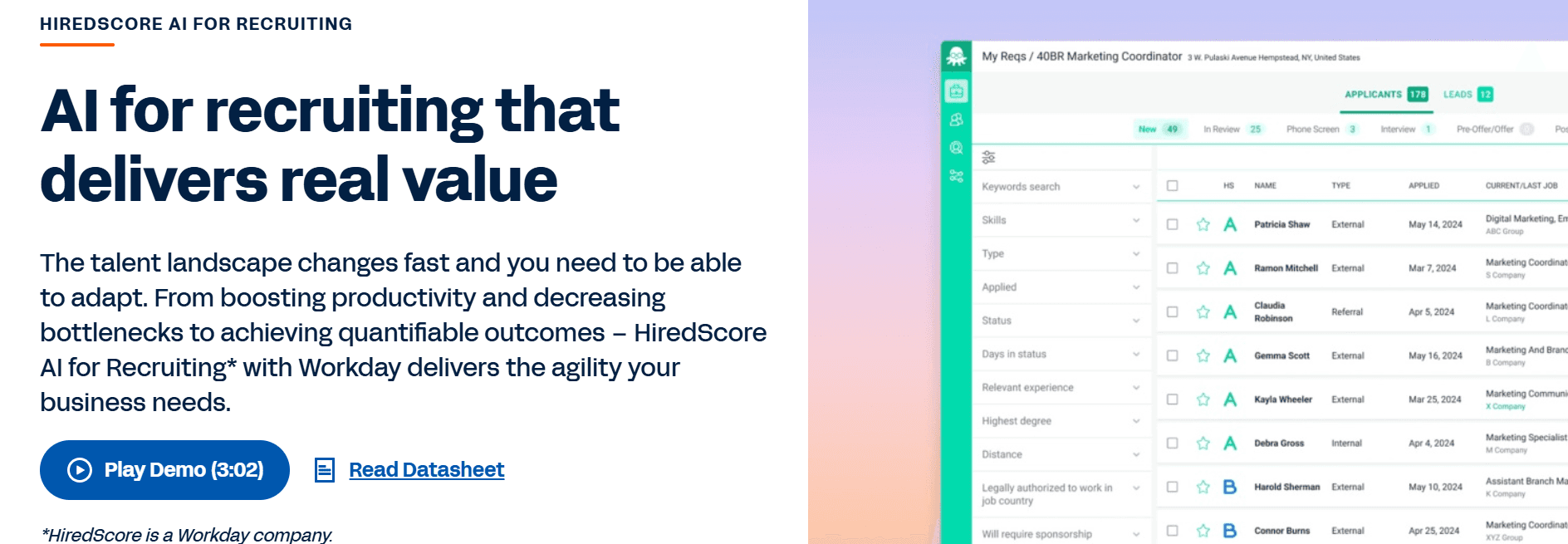
HiredScore uses responsible AI to match and prioritize candidates across external and internal pools while supporting bias audits and privacy. It integrates with HR systems and offers productivity tools for hiring managers to speed decision-making.
Standout Features
Automation that matches and prioritizes candidates across all talent sources
Bias audit capabilities and local compliance support for ethical AI use
Internal mobility and talent rediscovery to leverage existing people
Hiring manager productivity hub for alignment and scheduling
Pros
Substantial compliance and bias mitigation features for regulated environments.
Cons
Enterprise integration and governance needs can add implementation overhead.
36. Jobvite: Relationship-Driven Talent Platform
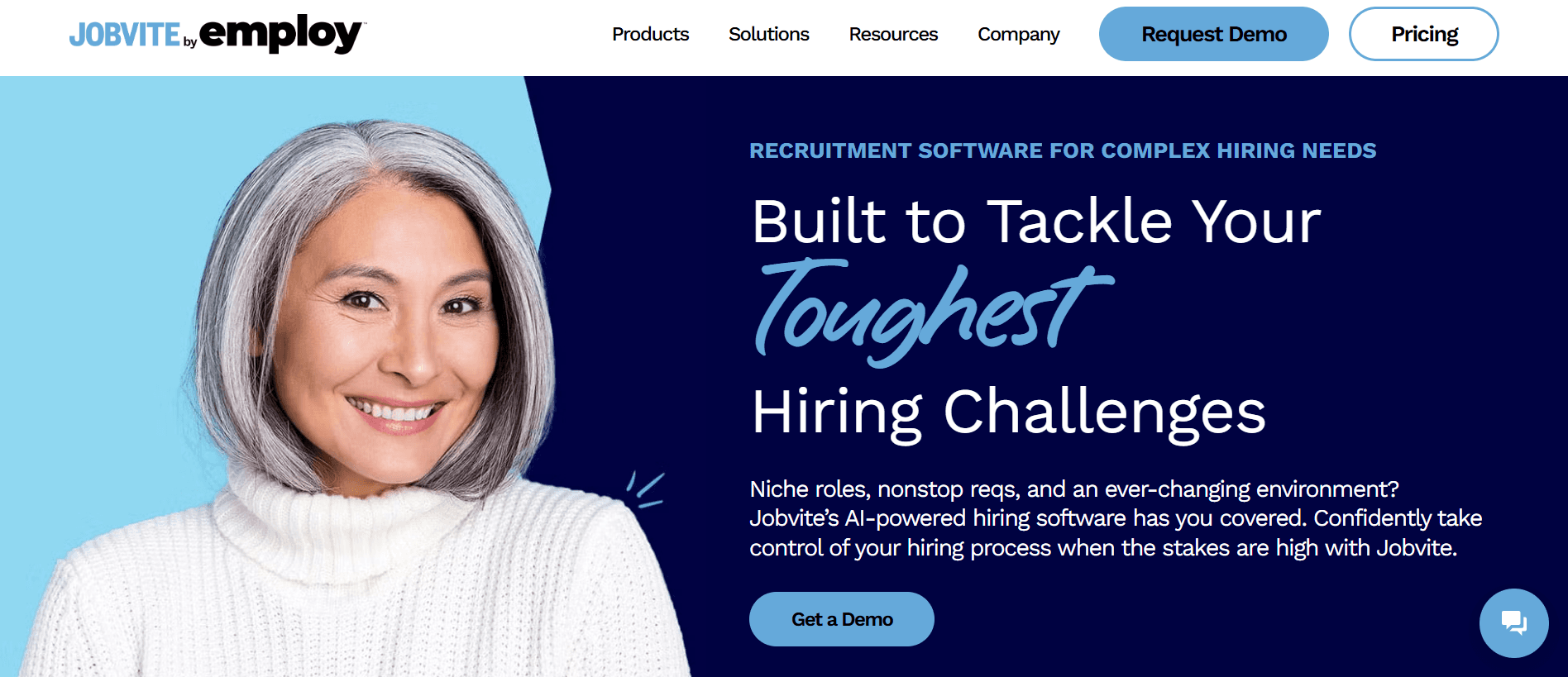
Jobvite is a talent acquisition suite that covers:
Recruitment marketing
Applicant management
Onboarding
Internal mobility
It uses AI chatbots and automation to build talent relationships and deliver data-driven hiring improvements.
Standout Features
Integrated suite covering employer branding through onboarding
Data-driven insights to identify and remove hiring bottlenecks
Benchmark reporting to compare hiring outcomes by industry
AI chatbot to automate screening, communications, and scheduling
Pros
Comprehensive platform that aligns recruitment marketing with hiring operations.
Cons
A full suite requires commitment to leverage end-to-end functionality effectively.
37. pymetrics: Behavioral Assessments for Better Fit

pymetrics uses gamified behavioral assessments and AI to match candidates to roles based on cognitive and emotional attributes. It helps teams reduce bias in placement and guides candidates toward jobs where they are likely to succeed and stay.
Standout Features
Gamified soft skill assessments to measure candidate potential objectively
Role guidance based on assessment outcomes to steer applicants to good fits
Integrations with major ATS platforms for automated workflows
Custom talent algorithms to tailor matching to business needs
Pros
Strong for matching on potential and improving retention with objective measures.
Cons
Behavioral assessments need cultural calibration to local hiring norms.
38. Recruitee: Collaborative Hiring with Employer Branding
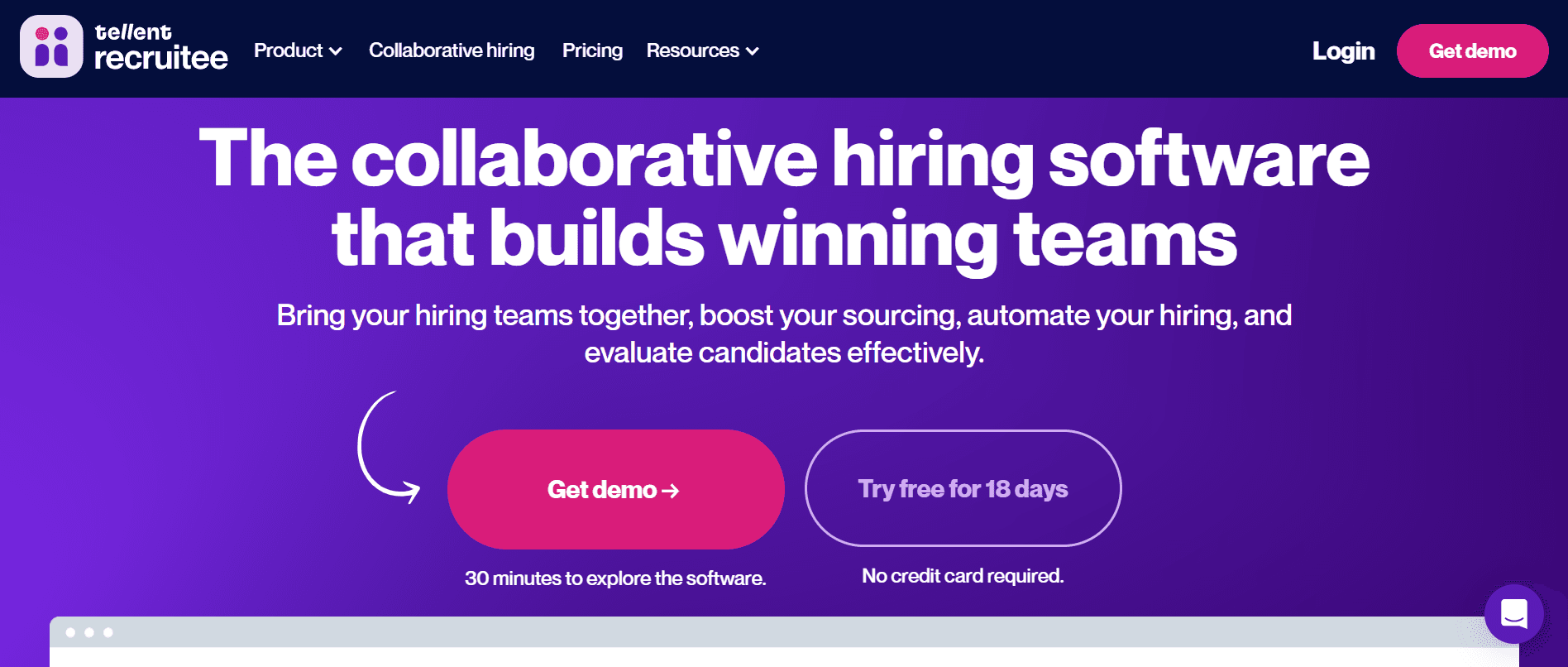
Recruitee combines collaborative hiring workflows, employer branding, and pipeline automation to help teams hire faster and maintain candidate experience. It offers career site builders and extensive integrations to centralize recruiting activity.
Standout Features
Branded career site templates without coding to improve the employer brand
Customizable candidate pipelines visible to all stakeholders
Automated scheduling, interview templates, notes, and comments for collaboration
Custom dashboards and 120-plus integrations with HR tools
Pros
Strong collaboration and branding tools that streamline hiring coordination.
Cons
May require process alignment to take full advantage of automation and integrations.
39. iSmartRecruit: Comprehensive Recruiting and CRM Tools
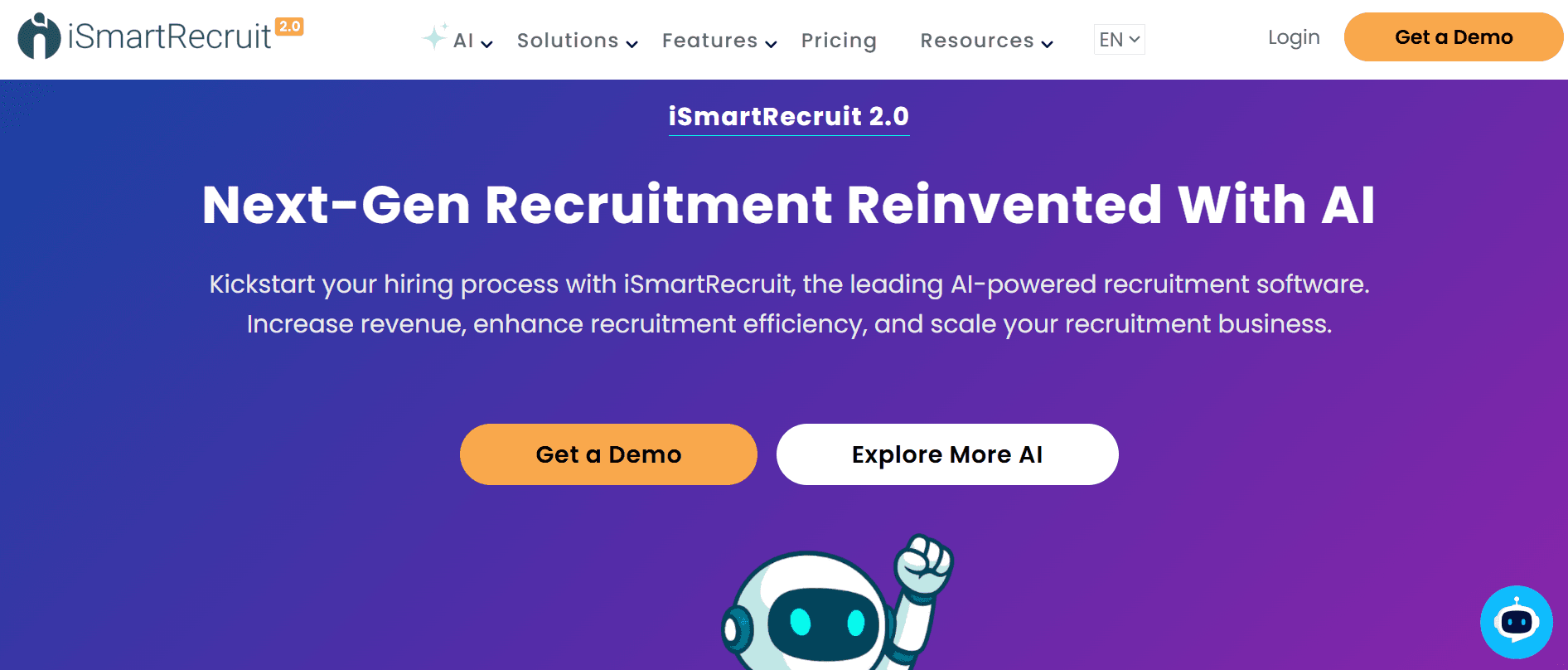
iSmartRecruit provides a suite of recruitment marketing, ATS, CRM, and automation tools with AI matching and chatbots. It centralizes candidate databases and automates communications to help recruiters nurture and convert talent faster.
Standout Features
Recruitment marketing with branded career pages and social recruiting
AI matching that searches candidate pools for skills and cultural fit
Customizable workflows to match organizational hiring processes
Candidate database and AI chatbots for candidate engagement and status updates
Pros
End-to-end recruiting tools and CRM capabilities centralize hiring data effectively.
Cons
Feature breadth can create a steeper learning curve for teams moving from simple systems.
Related Reading
• Toptal Alternatives
• Companies using AI for Recruitment
• AI Screening
• Toptal vs Gigster
• Andela Competitors
• Turing Alternatives
Upload a Job and Get 10 Candidates within 7 Days with Noxx (No Risk, No Upfront Fees)
Upload your job description, and Noxx starts sourcing within hours. The AI-driven recruiter parses the role with resume parsing and skills extraction, reaches candidate pools, and runs automated sourcing and outreach across multiple channels. It screens over 1,000 applicants with candidate scoring models and skills assessments, producing a ranked top 10 shortlist in seven days. Want to see which candidates surface for a hard-to-fill role?
Pricing That Puts Risk On Us
You pay nothing up front and only $300 when you actually hire someone. That replaces traditional recruiter commissions and retainer fees with a fee for results. This model aligns incentives with hiring outcomes and reduces cash flow pressure for:
Early-stage teams
Hiring managers
Talent acquisition leaders
How much could that change your hiring budget this quarter?
How Scale Meets Quality: Automated Screening at Volume
Noxx automates resume parsing, technical tests, and questionnaire screening so you can handle high volume without manual triage. The system uses machine learning recruiting to rank candidates by:
Skills fit
Past performance signals
Soft skills indicators
Human reviewers audit the shortlist to keep quality high and reduce false positives from automated filters. Would you like to see sample scoring metrics for engineers or salespeople?
Salary Transparency That Prevents Surprises
Each candidate profile shows salary expectations up front, so you avoid wasted interviews and late-stage mismatches. That salary visibility supports smarter budget allocation and faster offers. You can filter candidates by compensation band before committing time to interviews, improving candidate experience and reducing offer rejection. Do you prefer gross salary bands or total compensation ranges for screening?
Hire Engineers, Marketers, and Sales Talent at Lower Cost
Noxx sources vetted talent globally and locally, focusing on engineers, marketers, and salespeople who meet your technical and cultural criteria. The platform helps you find quality talent at up to 70% less than typical US rates by combining:
Global sourcing
Standardized assessments
Efficient candidate pipelines
Compliance checks, timezone notes, and contractor versus full-time flags appear in profiles so hiring teams can act quickly. Which role are you hiring first?
Automated Outreach Scheduling and Interview Workflow
Noxx automates outreach, interview scheduling, and follow-up so your calendar stays clean. Integration with calendar systems and ATS makes it easy to move candidates into live interviews and track progress. The platform generates interview kits and evaluation templates so interviewers assess consistent signals across candidates, improving hiring decisions and interview quality. Want to sync Noxx with your ATS and calendar?
Data Driven Hiring and Predictive Candidate Matching
The system applies predictive hiring models to surface candidates who historically convert to hires, using engagement signals and prior hire patterns. Recruitment automation reduces time to fill while producing reproducible candidate quality.
You get dashboards on pipeline velocity, source effectiveness, and candidate drop off so you can optimize sourcing channels and messaging quickly. Would metrics on time to hire and quality of hire help your next hiring plan?
Bias Mitigation and Human Oversight
Noxx anonymizes initial screening inputs and runs fairness checks across candidate scoring to lower biased signals. Final shortlists go through human review, so contextual factors and cultural fit remain part of the decision.
Audit logs track who made what decision and why, supporting compliance and transparent hiring practices. Do you want details on the fairness controls and audit features?
Integration With Existing Talent Stacks and Workflows
Built for teams that already use ATS tools, messaging platforms, and calendars, Noxx provides API and native integrations for smooth handoffs. Candidate profiles include CVs, test results, compensation expectations, and interview notes in one view so hiring managers and recruiters can make decisions without switching screens. How quickly do you want your first pipeline connected?
Why Modern Hiring Needs Recruitment Automation
Recruiting today demands:
Speed
Repeatability
Measurable results
Noxx combines recruitment automation, candidate matching, and intelligent candidate discovery to lower cost per hire and reduce time to fill. For startups and scale-ups, that means more interviews with qualified candidates, lower recruiter overhead, and a cleaner pipeline for growth hiring. Ready to change how your team finds talent?

